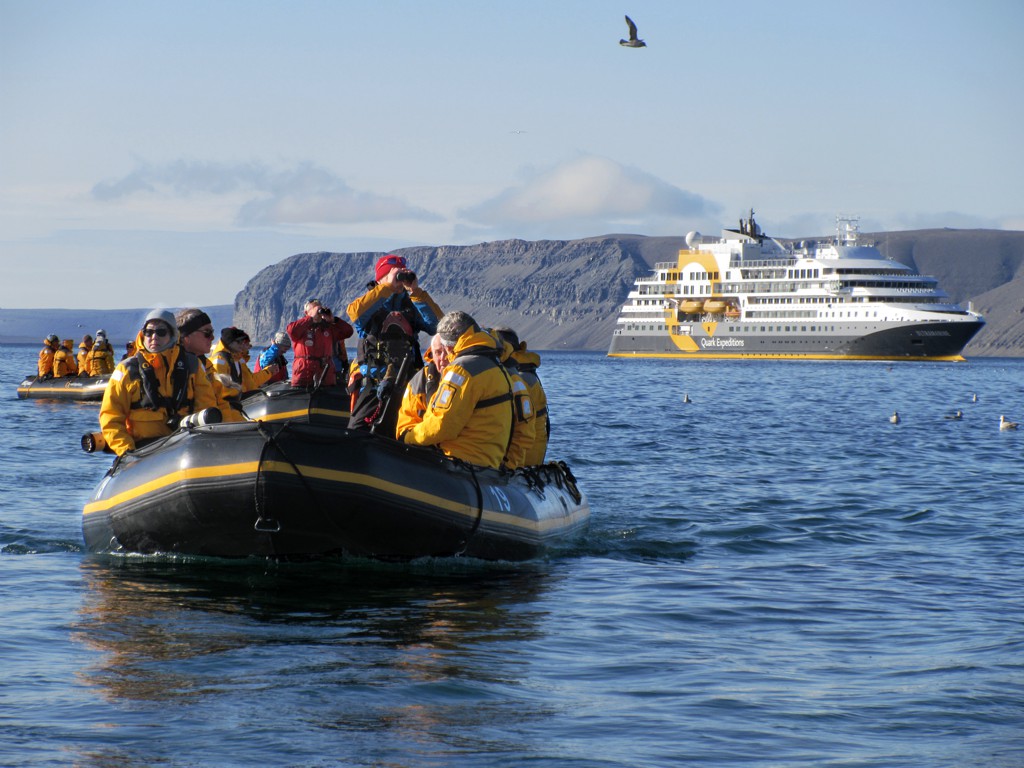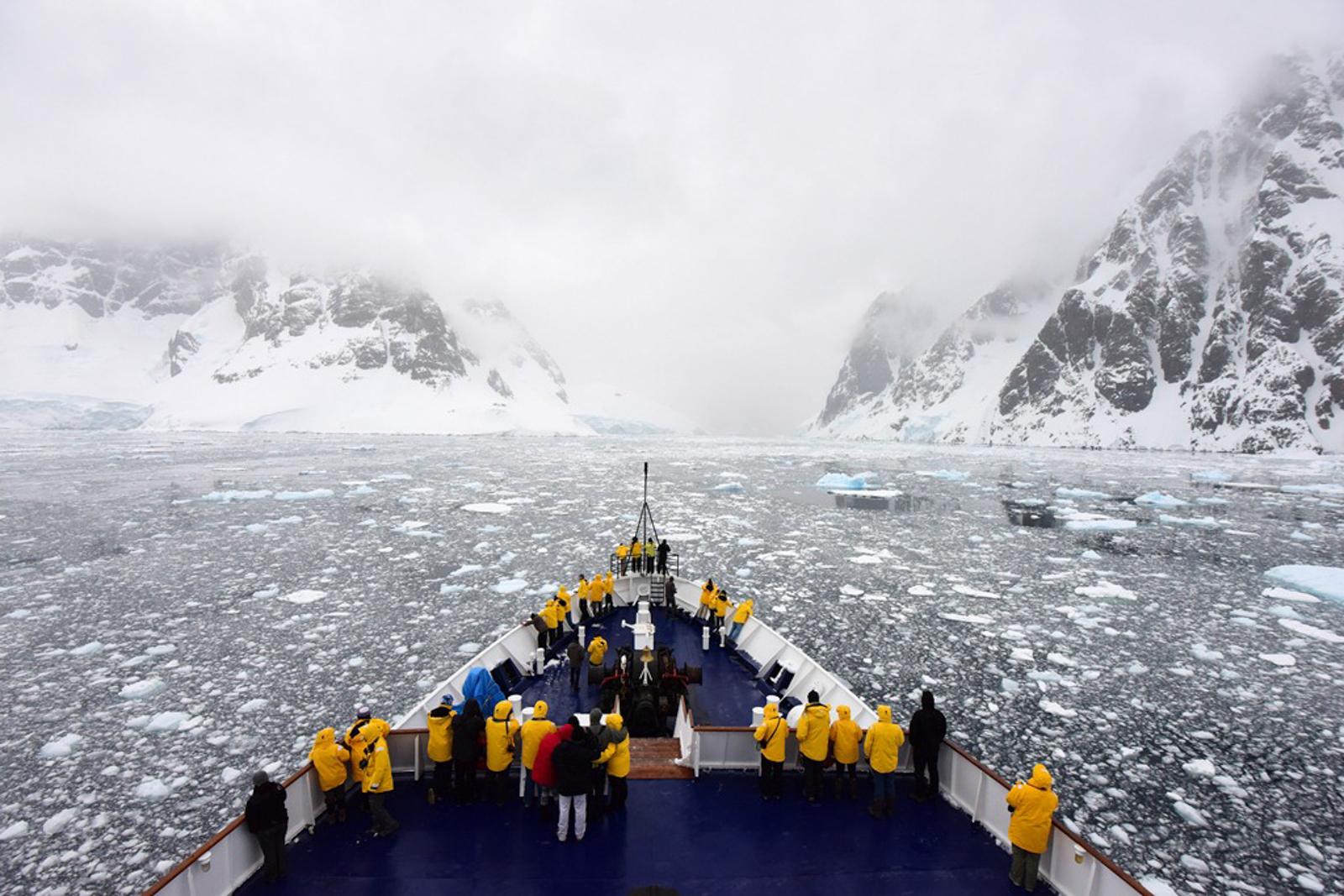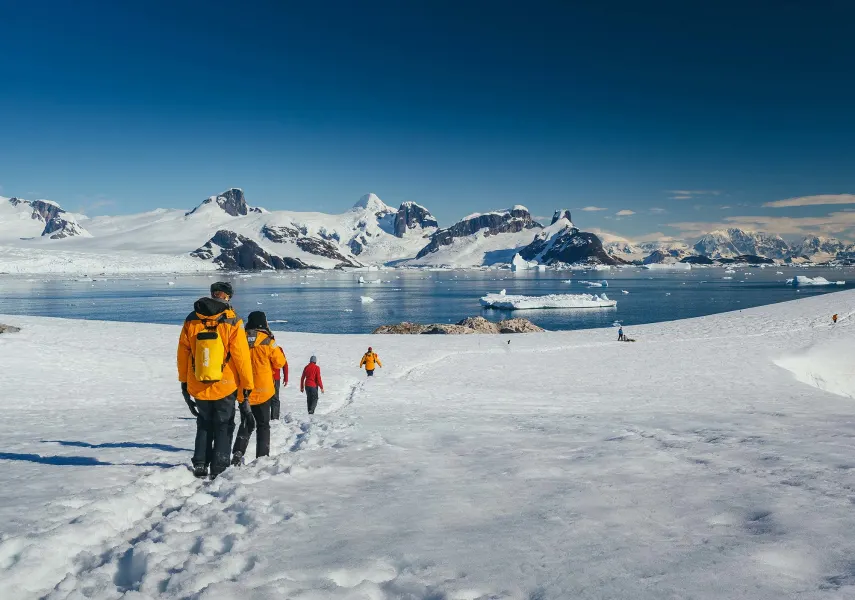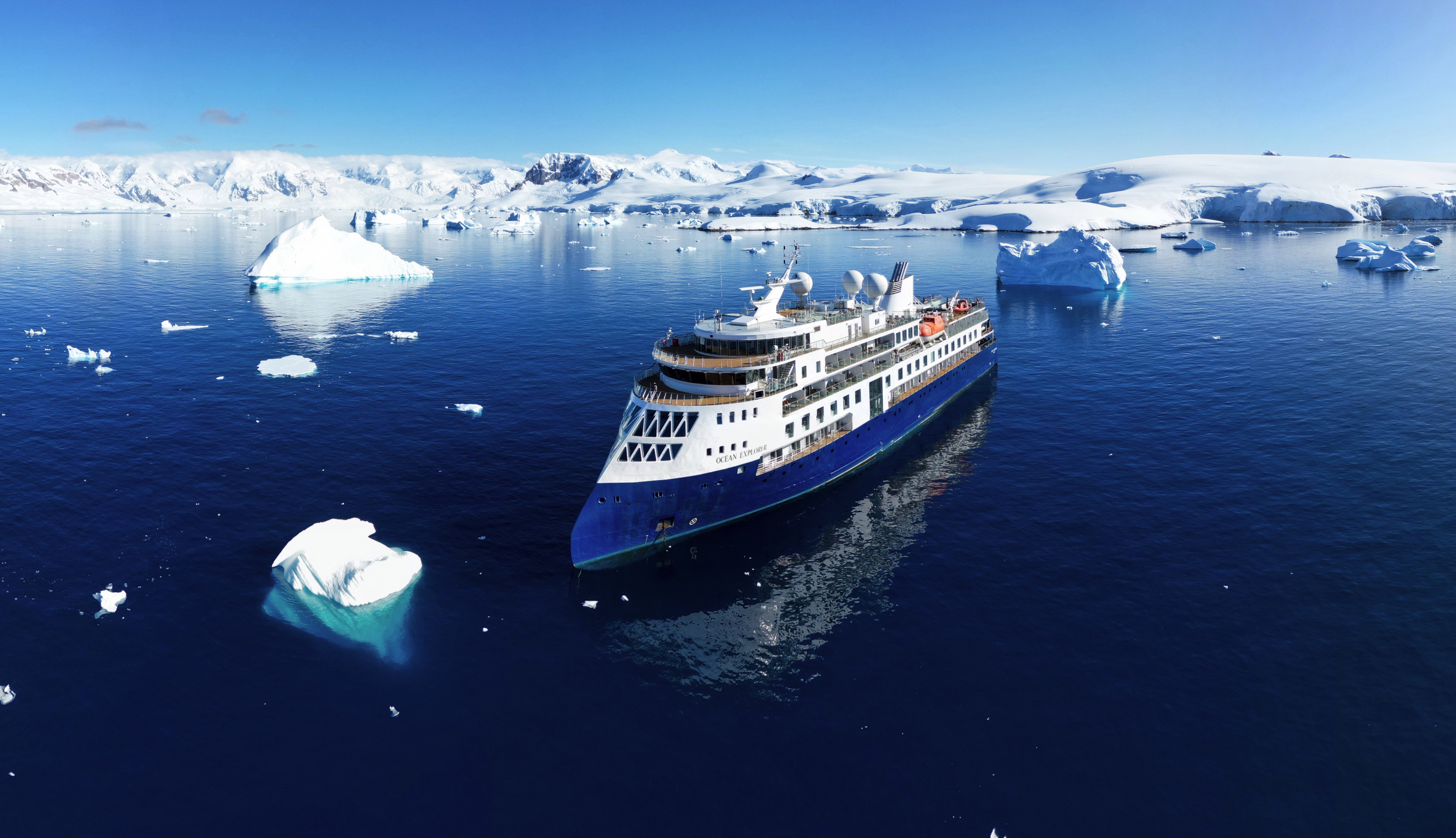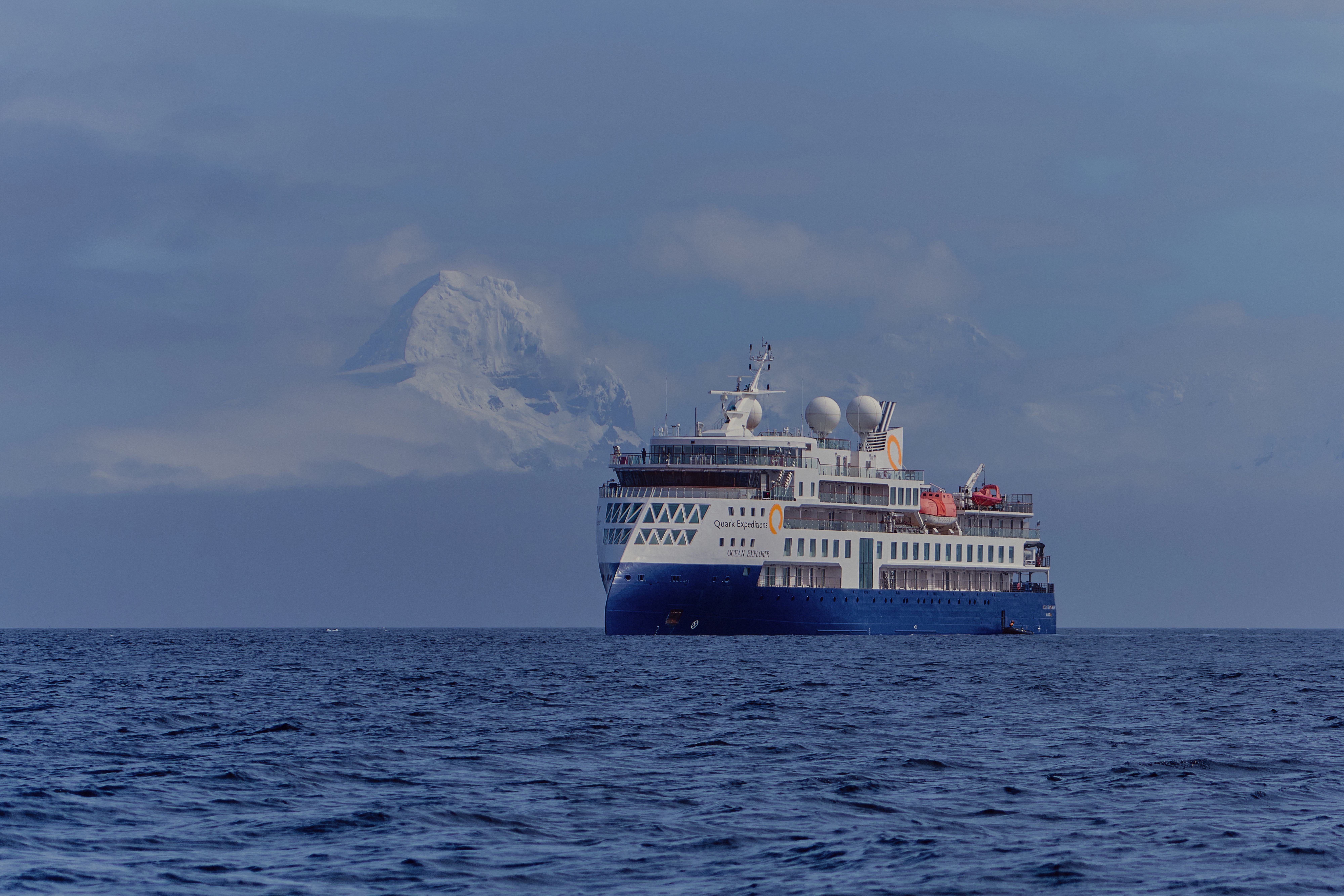Itinerary
A city of the sea, Helsinki was built along a series of oddly shaped peninsulas and islands jutting into the Baltic coast along the Gulf of Finland. Streets and avenues curve around bays, bridges reach to nearby islands, and ferries ply among offshore islands.Having grown dramatically since World War II, Helsinki now absorbs more than one-tenth of the Finnish population. The metro area covers 764 square km (474 square miles) and 315 islands. Most sights, hotels, and restaurants cluster on one peninsula, forming a compact central hub. The greater Helsinki metropolitan area, which includes Espoo and Vantaa, has a total population of more than a million people.Helsinki is a relatively young city compared with other European capitals. In the 16th century, King Gustav Vasa of Sweden decided to woo trade from the Estonian city of Tallinn and thus challenge the Hanseatic League’s monopoly on Baltic trade. Accordingly, he commanded the people of four Finnish towns to pack up their belongings and relocate to the rapids on the River Vantaa. The new town, founded on June 12, 1550, was named Helsinki.For three centuries, Helsinki (Helsingfors in Swedish) had its ups and downs as a trading town. Turku, to the west, remained Finland’s capital and intellectual center. However, Helsinki’s fortunes improved when Finland fell under Russian rule as an autonomous grand duchy. Czar Alexander I wanted Finland’s political center closer to Russia and, in 1812, selected Helsinki as the new capital. Shortly afterward, Turku suffered a disastrous fire, forcing the university to move to Helsinki. The town’s future was secure.Just before the czar’s proclamation, a fire destroyed many of Helsinki’s traditional wooden structures, precipitating the construction of new buildings suitable for a nation’s capital. The German-born architect Carl Ludvig Engel was commissioned to rebuild the city, and as a result, Helsinki has some of the purest neoclassical architecture in the world. Add to this foundation the influence of Stockholm and St. Petersburg with the local inspiration of 20th-century Finnish design, and the result is a European capital city that is as architecturally eye-catching as it is distinct from other Scandinavian capitals. You are bound to discover endless engaging details—a grimacing gargoyle; a foursome of males supporting a balcony’s weight on their shoulders; a building painted in striking colors with contrasting flowers in the windows. The city’s 400 or so parks make it particularly inviting in summer.Today, Helsinki is still a meeting point of eastern and western Europe, which is reflected in its cosmopolitan image, the influx of Russians and Estonians, and generally multilingual population. Outdoor summer bars (“terrassit” as the locals call them) and cafés in the city center are perfect for people watching on a summer afternoon.
Day programme:
Your Arctic adventure begins in Helsinki, renowned for its extraordinary architecture and intriguing mix of eastern and western influences. If you arrive early, explore the many museums, galleries and restaurants, relax at a Finnish sauna or wander the vibrant Design District before retiring at your included hotel.
Longyearbyen is the biggest settlement in Svalbard. Seat of the Norwegian administration, it also has the best services and infrastructure in the archipelago. Located deep in the Adventfjord, a sidearm of the Isfjorden (Icefjord), Longyearbyen’s airport can be used all-year round, but its harbor is blocked by ice in winter. Most shops, hotels, restaurants and a hospital are within easy walking distance of the port. One of the most prominent buildings in town is the UNIS center, where several Norwegian universities have joined forces to operate and offer the northernmost higher education to both Norwegian and international students. Adjacent to UNIS, and well worth a visit, is the Svalbard Museum, covering the natural history and exploitation of Svalbard. Remnants of the former mining activity can be seen all around Longyearbyen and even in town.
Day programme:
This morning, the group will transfer to the airport and board our private charter flight to Longyearbyen, Spitsbergen’s largest settlement. As your ship sets sail, enjoy your first view of the island’s rugged, glacier-topped mountains rising majestically from frigid waters.
Day programme:
Expect a new adventure every day as we begin our journey by heading north and around the island of Spitsbergen, exploring smaller, outlying islands. We plan to circumnavigate Spitsbergen, but if conditions are favorable, we will also attempt a larger circumnavigation of the archipelago, including many of the outer islands in the Svalbard archipelago. Every expedition will be different, depending on the weather and ice, but some of the places we may visit include the 14th of July Glacier, Ny-London, Phippsøya, Alkefjellet and the seldom-visited Kvitøya.These names may seem strange to you, but each site has its own unique appeal. There is no shortage of natural beauty in Spitsbergen, where colorful tundra meadows are complemented by immense glaciers. For birders, 14th of July Bay is home to puffins, purple sandpipers, black-legged kittiwakes, pink-footed geese, and barnacle geese, while Alkefjellet’s cliffs are teeming with nesting Brünnich’s guillemots (thick-billed murres).Always on the lookout for wildlife, be sure to have your camera ready to capture reindeer when we visit sites like Ny-London, Sundneset and Alkhornet. Searching for the iconic polar bear is a constant activity for your Expedition Team. Phippsøya and Isbukta are often home to sea ice, the bears’ preferred habitat for hunting, which translates into great potential for you to view and capture them in action.A big part of appreciating Spitsbergen comes from understanding the history—not just how people live today, but also how this land was first explored. Whaling was a key industry, and you will see remains of outposts from the 16th century, plus other evidence of whaling at landing sites such as Smeerenburg.
Day programme:
Expect a new adventure every day as we begin our journey by heading north and around the island of Spitsbergen, exploring smaller, outlying islands. We plan to circumnavigate Spitsbergen, but if conditions are favorable, we will also attempt a larger circumnavigation of the archipelago, including many of the outer islands in the Svalbard archipelago. Every expedition will be different, depending on the weather and ice, but some of the places we may visit include the 14th of July Glacier, Ny-London, Phippsøya, Alkefjellet and the seldom-visited Kvitøya.These names may seem strange to you, but each site has its own unique appeal. There is no shortage of natural beauty in Spitsbergen, where colorful tundra meadows are complemented by immense glaciers. For birders, 14th of July Bay is home to puffins, purple sandpipers, black-legged kittiwakes, pink-footed geese, and barnacle geese, while Alkefjellet’s cliffs are teeming with nesting Brünnich’s guillemots (thick-billed murres).Always on the lookout for wildlife, be sure to have your camera ready to capture reindeer when we visit sites like Ny-London, Sundneset and Alkhornet. Searching for the iconic polar bear is a constant activity for your Expedition Team. Phippsøya and Isbukta are often home to sea ice, the bears’ preferred habitat for hunting, which translates into great potential for you to view and capture them in action.A big part of appreciating Spitsbergen comes from understanding the history—not just how people live today, but also how this land was first explored. Whaling was a key industry, and you will see remains of outposts from the 16th century, plus other evidence of whaling at landing sites such as Smeerenburg.
Day programme:
Expect a new adventure every day as we begin our journey by heading north and around the island of Spitsbergen, exploring smaller, outlying islands. We plan to circumnavigate Spitsbergen, but if conditions are favorable, we will also attempt a larger circumnavigation of the archipelago, including many of the outer islands in the Svalbard archipelago. Every expedition will be different, depending on the weather and ice, but some of the places we may visit include the 14th of July Glacier, Ny-London, Phippsøya, Alkefjellet and the seldom-visited Kvitøya.These names may seem strange to you, but each site has its own unique appeal. There is no shortage of natural beauty in Spitsbergen, where colorful tundra meadows are complemented by immense glaciers. For birders, 14th of July Bay is home to puffins, purple sandpipers, black-legged kittiwakes, pink-footed geese, and barnacle geese, while Alkefjellet’s cliffs are teeming with nesting Brünnich’s guillemots (thick-billed murres).Always on the lookout for wildlife, be sure to have your camera ready to capture reindeer when we visit sites like Ny-London, Sundneset and Alkhornet. Searching for the iconic polar bear is a constant activity for your Expedition Team. Phippsøya and Isbukta are often home to sea ice, the bears’ preferred habitat for hunting, which translates into great potential for you to view and capture them in action.A big part of appreciating Spitsbergen comes from understanding the history—not just how people live today, but also how this land was first explored. Whaling was a key industry, and you will see remains of outposts from the 16th century, plus other evidence of whaling at landing sites such as Smeerenburg.
Day programme:
Expect a new adventure every day as we begin our journey by heading north and around the island of Spitsbergen, exploring smaller, outlying islands. We plan to circumnavigate Spitsbergen, but if conditions are favorable, we will also attempt a larger circumnavigation of the archipelago, including many of the outer islands in the Svalbard archipelago. Every expedition will be different, depending on the weather and ice, but some of the places we may visit include the 14th of July Glacier, Ny-London, Phippsøya, Alkefjellet and the seldom-visited Kvitøya.These names may seem strange to you, but each site has its own unique appeal. There is no shortage of natural beauty in Spitsbergen, where colorful tundra meadows are complemented by immense glaciers. For birders, 14th of July Bay is home to puffins, purple sandpipers, black-legged kittiwakes, pink-footed geese, and barnacle geese, while Alkefjellet’s cliffs are teeming with nesting Brünnich’s guillemots (thick-billed murres).Always on the lookout for wildlife, be sure to have your camera ready to capture reindeer when we visit sites like Ny-London, Sundneset and Alkhornet. Searching for the iconic polar bear is a constant activity for your Expedition Team. Phippsøya and Isbukta are often home to sea ice, the bears’ preferred habitat for hunting, which translates into great potential for you to view and capture them in action.A big part of appreciating Spitsbergen comes from understanding the history—not just how people live today, but also how this land was first explored. Whaling was a key industry, and you will see remains of outposts from the 16th century, plus other evidence of whaling at landing sites such as Smeerenburg.
Day programme:
Expect a new adventure every day as we begin our journey by heading north and around the island of Spitsbergen, exploring smaller, outlying islands. We plan to circumnavigate Spitsbergen, but if conditions are favorable, we will also attempt a larger circumnavigation of the archipelago, including many of the outer islands in the Svalbard archipelago. Every expedition will be different, depending on the weather and ice, but some of the places we may visit include the 14th of July Glacier, Ny-London, Phippsøya, Alkefjellet and the seldom-visited Kvitøya.These names may seem strange to you, but each site has its own unique appeal. There is no shortage of natural beauty in Spitsbergen, where colorful tundra meadows are complemented by immense glaciers. For birders, 14th of July Bay is home to puffins, purple sandpipers, black-legged kittiwakes, pink-footed geese, and barnacle geese, while Alkefjellet’s cliffs are teeming with nesting Brünnich’s guillemots (thick-billed murres).Always on the lookout for wildlife, be sure to have your camera ready to capture reindeer when we visit sites like Ny-London, Sundneset and Alkhornet. Searching for the iconic polar bear is a constant activity for your Expedition Team. Phippsøya and Isbukta are often home to sea ice, the bears’ preferred habitat for hunting, which translates into great potential for you to view and capture them in action.A big part of appreciating Spitsbergen comes from understanding the history—not just how people live today, but also how this land was first explored. Whaling was a key industry, and you will see remains of outposts from the 16th century, plus other evidence of whaling at landing sites such as Smeerenburg.
Day programme:
Expect a new adventure every day as we begin our journey by heading north and around the island of Spitsbergen, exploring smaller, outlying islands. We plan to circumnavigate Spitsbergen, but if conditions are favorable, we will also attempt a larger circumnavigation of the archipelago, including many of the outer islands in the Svalbard archipelago. Every expedition will be different, depending on the weather and ice, but some of the places we may visit include the 14th of July Glacier, Ny-London, Phippsøya, Alkefjellet and the seldom-visited Kvitøya.These names may seem strange to you, but each site has its own unique appeal. There is no shortage of natural beauty in Spitsbergen, where colorful tundra meadows are complemented by immense glaciers. For birders, 14th of July Bay is home to puffins, purple sandpipers, black-legged kittiwakes, pink-footed geese, and barnacle geese, while Alkefjellet’s cliffs are teeming with nesting Brünnich’s guillemots (thick-billed murres).Always on the lookout for wildlife, be sure to have your camera ready to capture reindeer when we visit sites like Ny-London, Sundneset and Alkhornet. Searching for the iconic polar bear is a constant activity for your Expedition Team. Phippsøya and Isbukta are often home to sea ice, the bears’ preferred habitat for hunting, which translates into great potential for you to view and capture them in action.A big part of appreciating Spitsbergen comes from understanding the history—not just how people live today, but also how this land was first explored. Whaling was a key industry, and you will see remains of outposts from the 16th century, plus other evidence of whaling at landing sites such as Smeerenburg.
Day programme:
Expect a new adventure every day as we begin our journey by heading north and around the island of Spitsbergen, exploring smaller, outlying islands. We plan to circumnavigate Spitsbergen, but if conditions are favorable, we will also attempt a larger circumnavigation of the archipelago, including many of the outer islands in the Svalbard archipelago. Every expedition will be different, depending on the weather and ice, but some of the places we may visit include the 14th of July Glacier, Ny-London, Phippsøya, Alkefjellet and the seldom-visited Kvitøya.These names may seem strange to you, but each site has its own unique appeal. There is no shortage of natural beauty in Spitsbergen, where colorful tundra meadows are complemented by immense glaciers. For birders, 14th of July Bay is home to puffins, purple sandpipers, black-legged kittiwakes, pink-footed geese, and barnacle geese, while Alkefjellet’s cliffs are teeming with nesting Brünnich’s guillemots (thick-billed murres).Always on the lookout for wildlife, be sure to have your camera ready to capture reindeer when we visit sites like Ny-London, Sundneset and Alkhornet. Searching for the iconic polar bear is a constant activity for your Expedition Team. Phippsøya and Isbukta are often home to sea ice, the bears’ preferred habitat for hunting, which translates into great potential for you to view and capture them in action.A big part of appreciating Spitsbergen comes from understanding the history—not just how people live today, but also how this land was first explored. Whaling was a key industry, and you will see remains of outposts from the 16th century, plus other evidence of whaling at landing sites such as Smeerenburg.
Day programme:
Expect a new adventure every day as we begin our journey by heading north and around the island of Spitsbergen, exploring smaller, outlying islands. We plan to circumnavigate Spitsbergen, but if conditions are favorable, we will also attempt a larger circumnavigation of the archipelago, including many of the outer islands in the Svalbard archipelago. Every expedition will be different, depending on the weather and ice, but some of the places we may visit include the 14th of July Glacier, Ny-London, Phippsøya, Alkefjellet and the seldom-visited Kvitøya.These names may seem strange to you, but each site has its own unique appeal. There is no shortage of natural beauty in Spitsbergen, where colorful tundra meadows are complemented by immense glaciers. For birders, 14th of July Bay is home to puffins, purple sandpipers, black-legged kittiwakes, pink-footed geese, and barnacle geese, while Alkefjellet’s cliffs are teeming with nesting Brünnich’s guillemots (thick-billed murres).Always on the lookout for wildlife, be sure to have your camera ready to capture reindeer when we visit sites like Ny-London, Sundneset and Alkhornet. Searching for the iconic polar bear is a constant activity for your Expedition Team. Phippsøya and Isbukta are often home to sea ice, the bears’ preferred habitat for hunting, which translates into great potential for you to view and capture them in action.A big part of appreciating Spitsbergen comes from understanding the history—not just how people live today, but also how this land was first explored. Whaling was a key industry, and you will see remains of outposts from the 16th century, plus other evidence of whaling at landing sites such as Smeerenburg.
Day programme:
Expect a new adventure every day as we begin our journey by heading north and around the island of Spitsbergen, exploring smaller, outlying islands. We plan to circumnavigate Spitsbergen, but if conditions are favorable, we will also attempt a larger circumnavigation of the archipelago, including many of the outer islands in the Svalbard archipelago. Every expedition will be different, depending on the weather and ice, but some of the places we may visit include the 14th of July Glacier, Ny-London, Phippsøya, Alkefjellet and the seldom-visited Kvitøya.These names may seem strange to you, but each site has its own unique appeal. There is no shortage of natural beauty in Spitsbergen, where colorful tundra meadows are complemented by immense glaciers. For birders, 14th of July Bay is home to puffins, purple sandpipers, black-legged kittiwakes, pink-footed geese, and barnacle geese, while Alkefjellet’s cliffs are teeming with nesting Brünnich’s guillemots (thick-billed murres).Always on the lookout for wildlife, be sure to have your camera ready to capture reindeer when we visit sites like Ny-London, Sundneset and Alkhornet. Searching for the iconic polar bear is a constant activity for your Expedition Team. Phippsøya and Isbukta are often home to sea ice, the bears’ preferred habitat for hunting, which translates into great potential for you to view and capture them in action.A big part of appreciating Spitsbergen comes from understanding the history—not just how people live today, but also how this land was first explored. Whaling was a key industry, and you will see remains of outposts from the 16th century, plus other evidence of whaling at landing sites such as Smeerenburg.
Day programme:
Expect a new adventure every day as we begin our journey by heading north and around the island of Spitsbergen, exploring smaller, outlying islands. We plan to circumnavigate Spitsbergen, but if conditions are favorable, we will also attempt a larger circumnavigation of the archipelago, including many of the outer islands in the Svalbard archipelago. Every expedition will be different, depending on the weather and ice, but some of the places we may visit include the 14th of July Glacier, Ny-London, Phippsøya, Alkefjellet and the seldom-visited Kvitøya.These names may seem strange to you, but each site has its own unique appeal. There is no shortage of natural beauty in Spitsbergen, where colorful tundra meadows are complemented by immense glaciers. For birders, 14th of July Bay is home to puffins, purple sandpipers, black-legged kittiwakes, pink-footed geese, and barnacle geese, while Alkefjellet’s cliffs are teeming with nesting Brünnich’s guillemots (thick-billed murres).Always on the lookout for wildlife, be sure to have your camera ready to capture reindeer when we visit sites like Ny-London, Sundneset and Alkhornet. Searching for the iconic polar bear is a constant activity for your Expedition Team. Phippsøya and Isbukta are often home to sea ice, the bears’ preferred habitat for hunting, which translates into great potential for you to view and capture them in action.A big part of appreciating Spitsbergen comes from understanding the history—not just how people live today, but also how this land was first explored. Whaling was a key industry, and you will see remains of outposts from the 16th century, plus other evidence of whaling at landing sites such as Smeerenburg.
Day programme:
Expect a new adventure every day as we begin our journey by heading north and around the island of Spitsbergen, exploring smaller, outlying islands. We plan to circumnavigate Spitsbergen, but if conditions are favorable, we will also attempt a larger circumnavigation of the archipelago, including many of the outer islands in the Svalbard archipelago. Every expedition will be different, depending on the weather and ice, but some of the places we may visit include the 14th of July Glacier, Ny-London, Phippsøya, Alkefjellet and the seldom-visited Kvitøya.These names may seem strange to you, but each site has its own unique appeal. There is no shortage of natural beauty in Spitsbergen, where colorful tundra meadows are complemented by immense glaciers. For birders, 14th of July Bay is home to puffins, purple sandpipers, black-legged kittiwakes, pink-footed geese, and barnacle geese, while Alkefjellet’s cliffs are teeming with nesting Brünnich’s guillemots (thick-billed murres).Always on the lookout for wildlife, be sure to have your camera ready to capture reindeer when we visit sites like Ny-London, Sundneset and Alkhornet. Searching for the iconic polar bear is a constant activity for your Expedition Team. Phippsøya and Isbukta are often home to sea ice, the bears’ preferred habitat for hunting, which translates into great potential for you to view and capture them in action.A big part of appreciating Spitsbergen comes from understanding the history—not just how people live today, but also how this land was first explored. Whaling was a key industry, and you will see remains of outposts from the 16th century, plus other evidence of whaling at landing sites such as Smeerenburg.
Longyearbyen is the biggest settlement in Svalbard. Seat of the Norwegian administration, it also has the best services and infrastructure in the archipelago. Located deep in the Adventfjord, a sidearm of the Isfjorden (Icefjord), Longyearbyen’s airport can be used all-year round, but its harbor is blocked by ice in winter. Most shops, hotels, restaurants and a hospital are within easy walking distance of the port. One of the most prominent buildings in town is the UNIS center, where several Norwegian universities have joined forces to operate and offer the northernmost higher education to both Norwegian and international students. Adjacent to UNIS, and well worth a visit, is the Svalbard Museum, covering the natural history and exploitation of Svalbard. Remnants of the former mining activity can be seen all around Longyearbyen and even in town.
Day programme:
Your adventure ends in the frontier-style settlement of Longyearbyen. From here, we’ll transfer you to the airport for your return group charter flight to Helsinki, included in the transfer package.
A city of the sea, Helsinki was built along a series of oddly shaped peninsulas and islands jutting into the Baltic coast along the Gulf of Finland. Streets and avenues curve around bays, bridges reach to nearby islands, and ferries ply among offshore islands.Having grown dramatically since World War II, Helsinki now absorbs more than one-tenth of the Finnish population. The metro area covers 764 square km (474 square miles) and 315 islands. Most sights, hotels, and restaurants cluster on one peninsula, forming a compact central hub. The greater Helsinki metropolitan area, which includes Espoo and Vantaa, has a total population of more than a million people.Helsinki is a relatively young city compared with other European capitals. In the 16th century, King Gustav Vasa of Sweden decided to woo trade from the Estonian city of Tallinn and thus challenge the Hanseatic League’s monopoly on Baltic trade. Accordingly, he commanded the people of four Finnish towns to pack up their belongings and relocate to the rapids on the River Vantaa. The new town, founded on June 12, 1550, was named Helsinki.For three centuries, Helsinki (Helsingfors in Swedish) had its ups and downs as a trading town. Turku, to the west, remained Finland’s capital and intellectual center. However, Helsinki’s fortunes improved when Finland fell under Russian rule as an autonomous grand duchy. Czar Alexander I wanted Finland’s political center closer to Russia and, in 1812, selected Helsinki as the new capital. Shortly afterward, Turku suffered a disastrous fire, forcing the university to move to Helsinki. The town’s future was secure.Just before the czar’s proclamation, a fire destroyed many of Helsinki’s traditional wooden structures, precipitating the construction of new buildings suitable for a nation’s capital. The German-born architect Carl Ludvig Engel was commissioned to rebuild the city, and as a result, Helsinki has some of the purest neoclassical architecture in the world. Add to this foundation the influence of Stockholm and St. Petersburg with the local inspiration of 20th-century Finnish design, and the result is a European capital city that is as architecturally eye-catching as it is distinct from other Scandinavian capitals. You are bound to discover endless engaging details—a grimacing gargoyle; a foursome of males supporting a balcony’s weight on their shoulders; a building painted in striking colors with contrasting flowers in the windows. The city’s 400 or so parks make it particularly inviting in summer.Today, Helsinki is still a meeting point of eastern and western Europe, which is reflected in its cosmopolitan image, the influx of Russians and Estonians, and generally multilingual population. Outdoor summer bars (“terrassit” as the locals call them) and cafés in the city center are perfect for people watching on a summer afternoon.
Day programme:
After breakfast, you can make your way to the airport for your onward flight home, or stay to explore Finland’s culturally-rich capital on your own if you’ve made prior arrangements.
Ship features
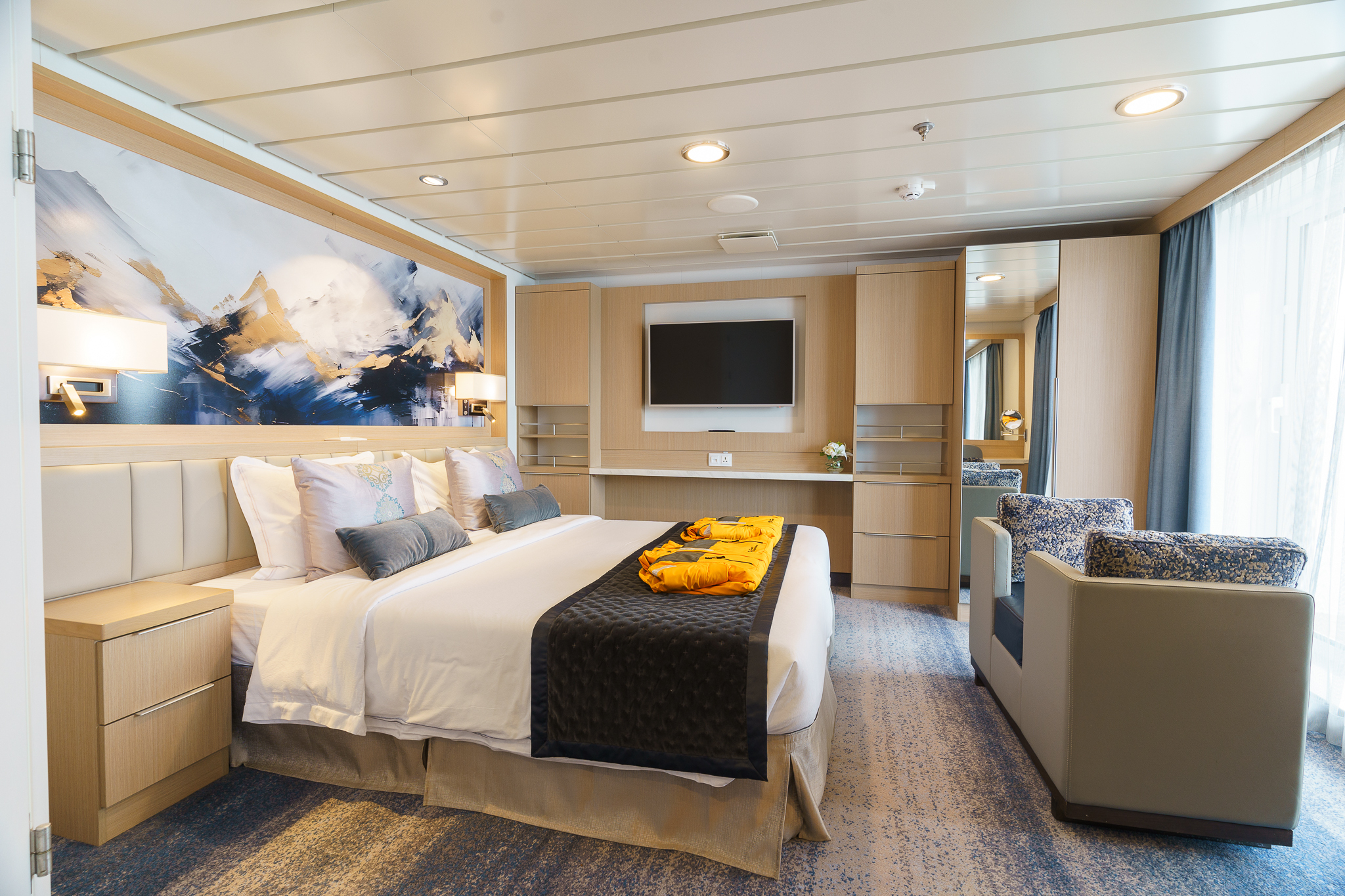
Owners Suite
This palatial, airy apartment offers stunning views from its large private veranda on the highest cabin level. The luxurious suite features a large master bedroom, living room and dining area and two large master bathrooms, among other amenities.
Bed Config.
Two rooms. One double bed made up of two twin berths fold out sofa bed
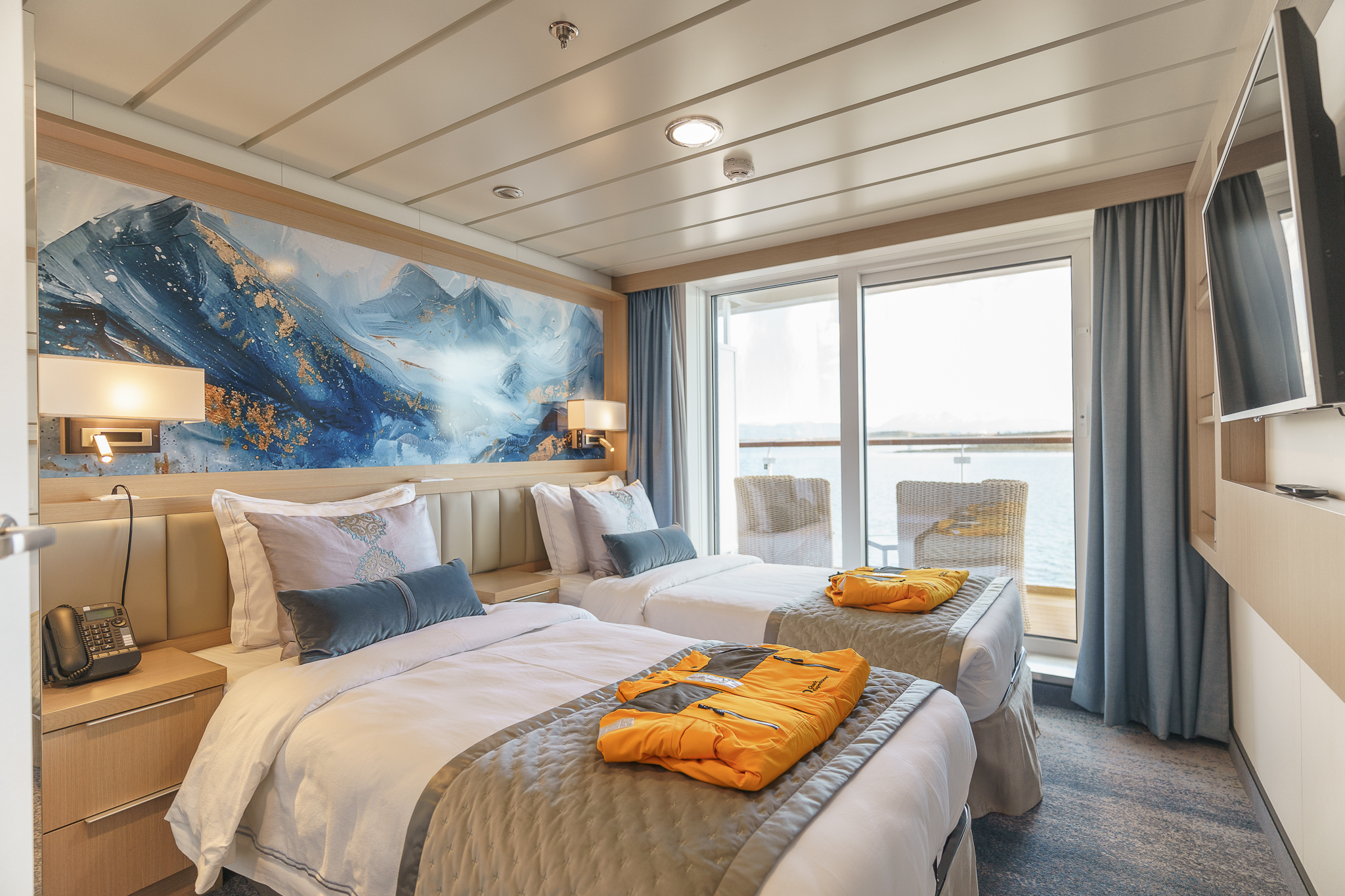
Junior Suite
Located on Deck 6 and approximately 298 sq. f. (27.7 sq. m,) in size. These 2-room suites have one double bed that can be configured into two singles in the inner bedroom and an outer sitting room furnished with a sofa-bed, and activity table for two. From the bedroom there a floor to ceiling glass view that opens to a double sized walkout balcony. There are also 2 TV’s, state of the art ‘infotainment’ system and private bathroom with bathtub, vanity and heated floor.
Bed Config.
Two rooms. One double bed made up of two twin berths fold out sofa bed
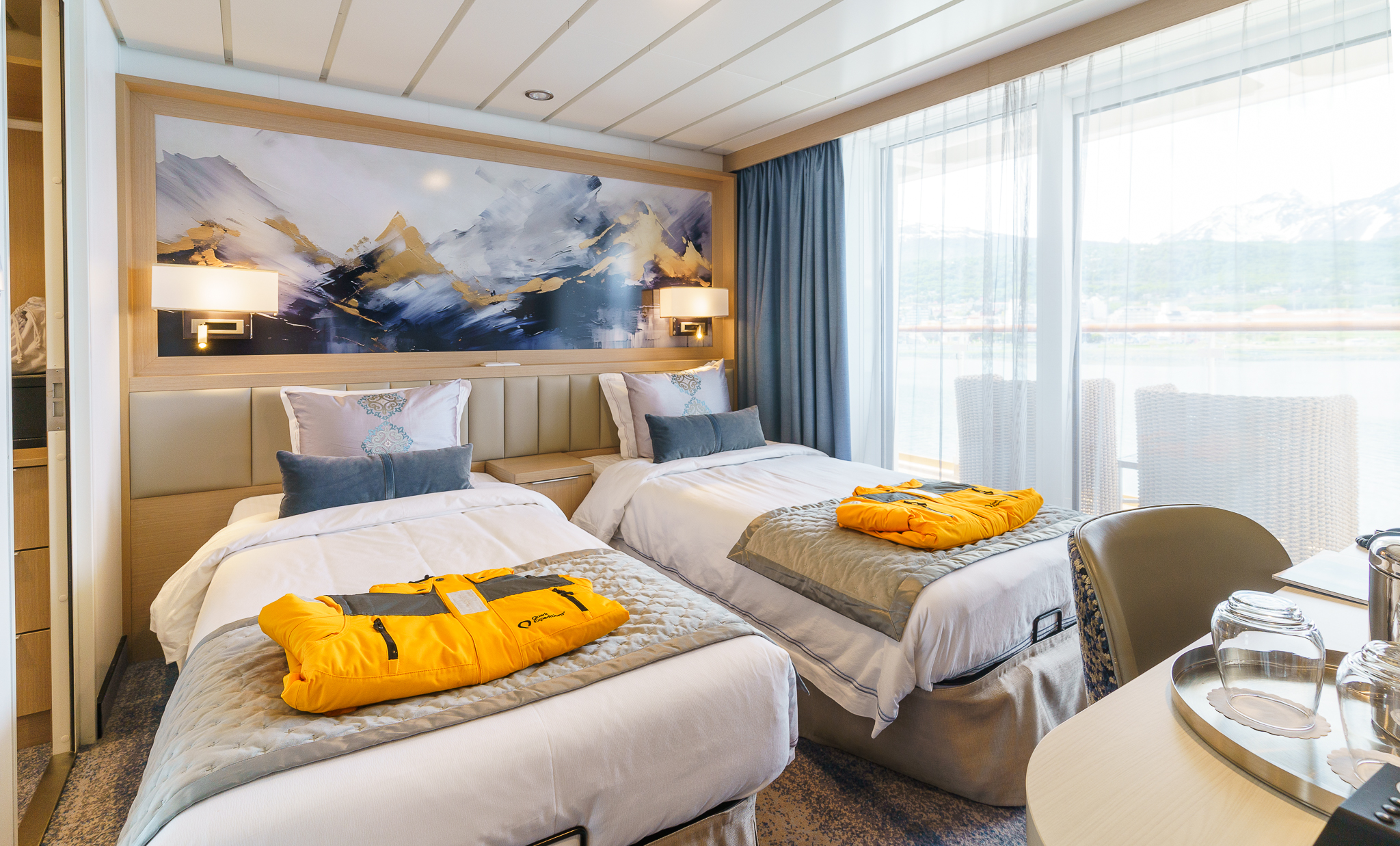
Penthouse Suite
This unique 2-room suite is located on Deck 7 and is approximately 269 sq. f (25.0 sq. m.) in size. It has one double bed that can be configured into two singles in the inner bedroom.and the outer sitting area is furnished with a sofa-bed. Walk-out from either room to a double sized balcony . There are also 2 TV’s, state of the art ‘infotainment’ system and private bathroom with shower, vanity and heated floor. And an additional powder room in the outside sitting area.
Bed Config.
Two rooms. One double bed made up of two twin berths fold out sofa bed
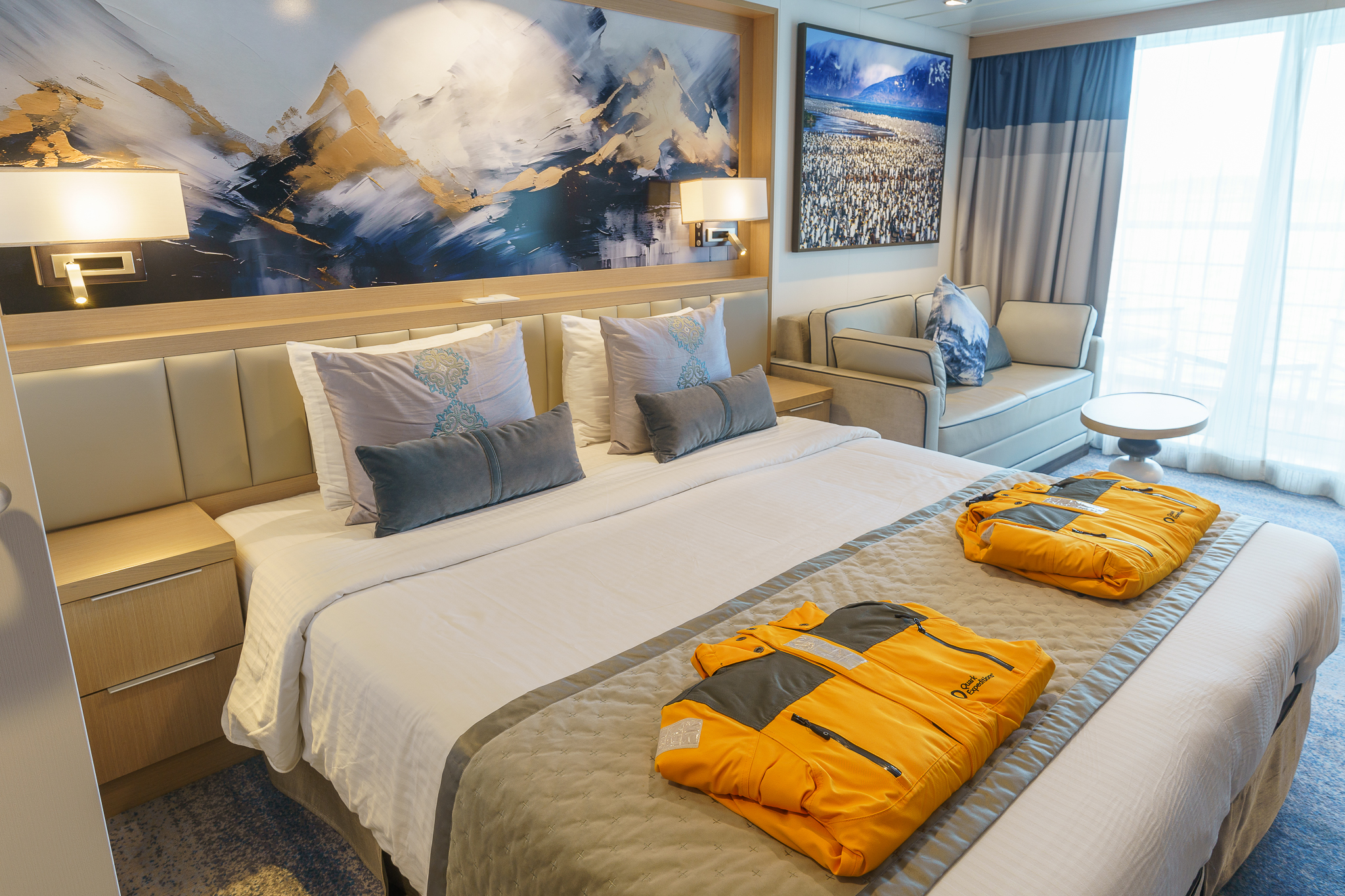
Veranda Suite
Located throughout the ship and approximately 205 sq. ft. (19.2 sq. m,) in size, these cabins have one double bed that can be configured into two singles, and seperate sitting area furnished with a sofa-bed. There is a floor to ceiling glass view that opens to a walkout balcony. There is also a desk and chair, TV, state of the art ‘infotainment’ system and private bathroom with shower, vanity and heated floor.
Bed Config.
One double bed made up of two twin berths and fold out sofa bed

Veranda Stateroom
Located throughout the ship and approximately 208 sq. f. (19.3 sq. m,) in size, these cabins have one double bed that can be configured into two singles, and seperate sitting area furnished with two club chairs and a reading table. There is a floor to ceiling glass view that opens to a walkout balcony. There is also a desk and chair, TV, state of the art ‘infotainment’ system and private bathroom with shower, vanity and heated floor. Note: 611 and 612 do not have the club chairs and a reading table.
Bed Config.
One double bed made up of two twin berths
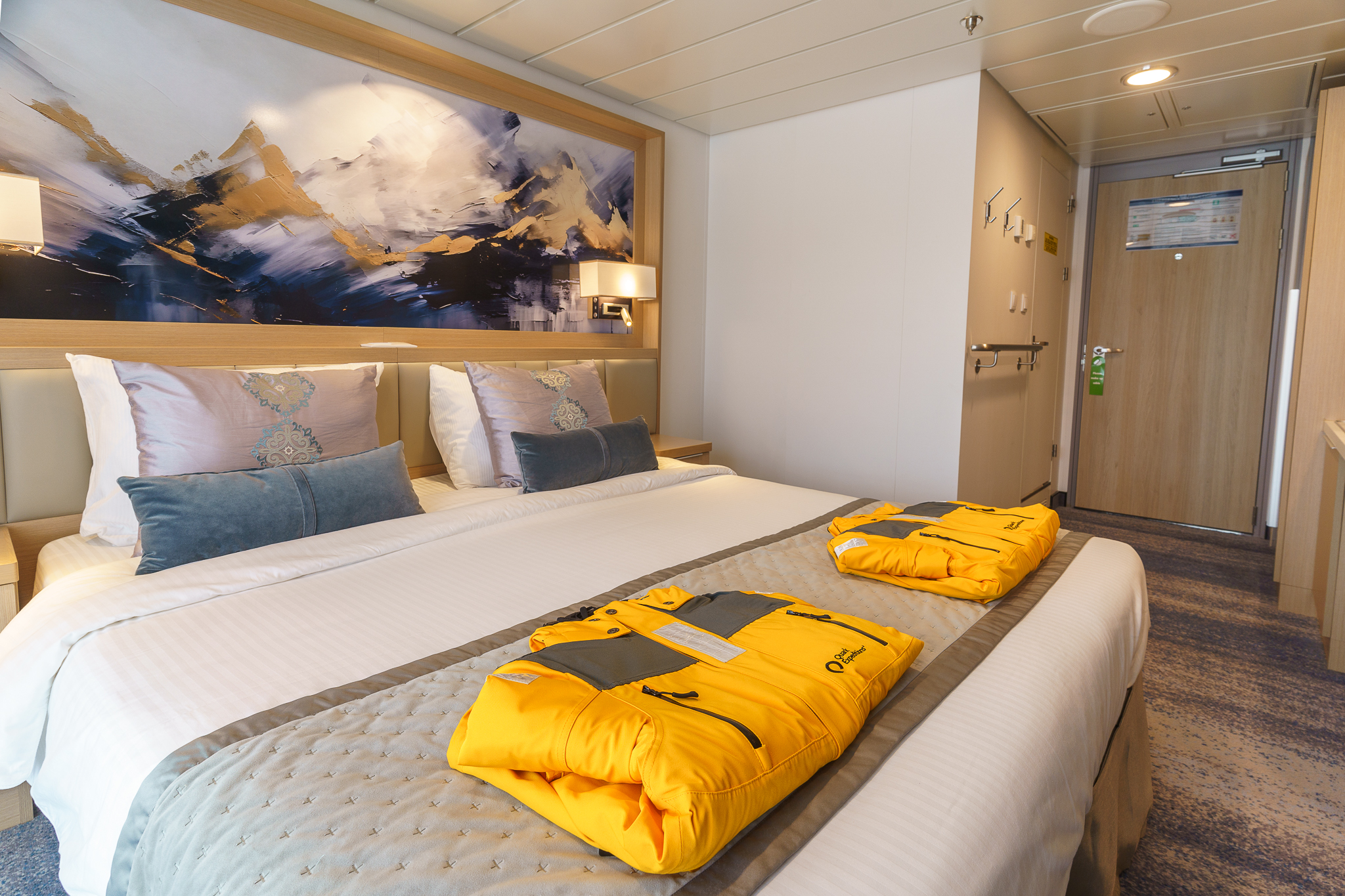
Deluxe Veranda Forward
Located on Deck 4 and approximately 182 sq. f. (16.9 sq. m,) in size, these cabins have one double bed that can be configured into two singles. There is a floor to ceiling glass view that opens to a walkout balcony. There is also a desk and chair, TV, state of the art ‘infotainment’ system and private bathroom with shower, vanity and heated floor.
Bed Config.
One double bed made up of two twin berths
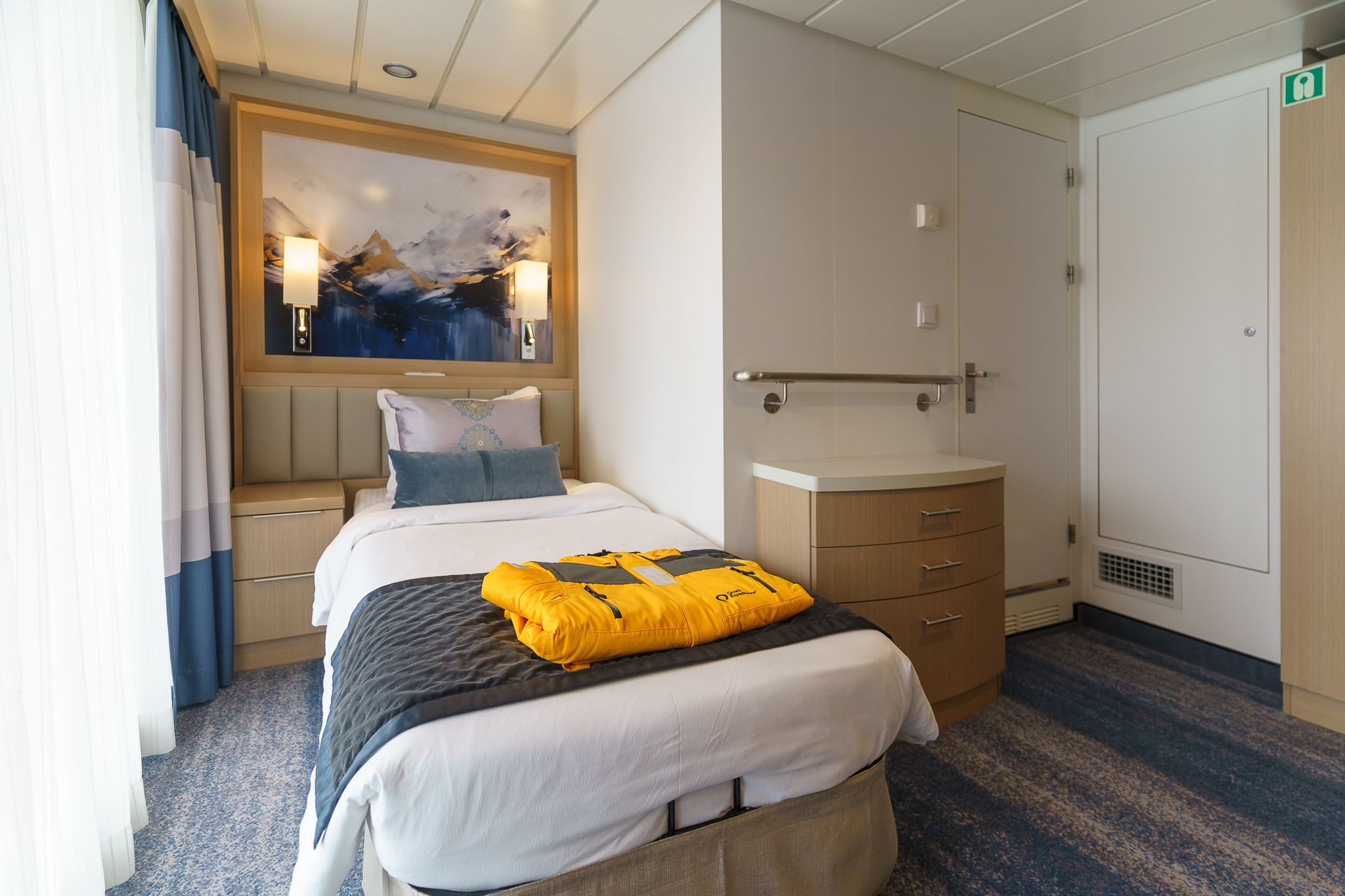
Studio Veranda Single
Designed for one. This unique cabin is located on Deck 7 and approximately 162 sq. f. (15.1 sq. m.). It has one twin bed with a floor to ceiling glass view that opens to a generous walkout balcony. There is also TV, state of the art ‘infotainment’ system and private bathroom with shower, vanity and heated floor.
Bed Config.
One twin single

Studio Single
Designed for one. These cabins are located on Deck 3 and approximately 166 sq. ft. (15,4 sq. m,) in size, with one double bed and a porthole view. There is also a desk and chair, TV, state of the art ‘infotainment’ system and private bathroom with shower, vanity and heated floor.
Bed Config.
One double bed made up of two twin berths

Main Dining Room
Contemporary meets cozy in this modern dining room with its stylish lighting and contemporary art. Located on Deck 5, the Main Dining Room seats 144 guests, and features expansive floor-to-ceiling windows that open onto the spectacular polar wilderness.

Private Dining Room
Tasteful and intimate. This stylish, private dining room on deck 5 provides a relaxed dining experience—with views of the polar landscape—for up to 36 guests.
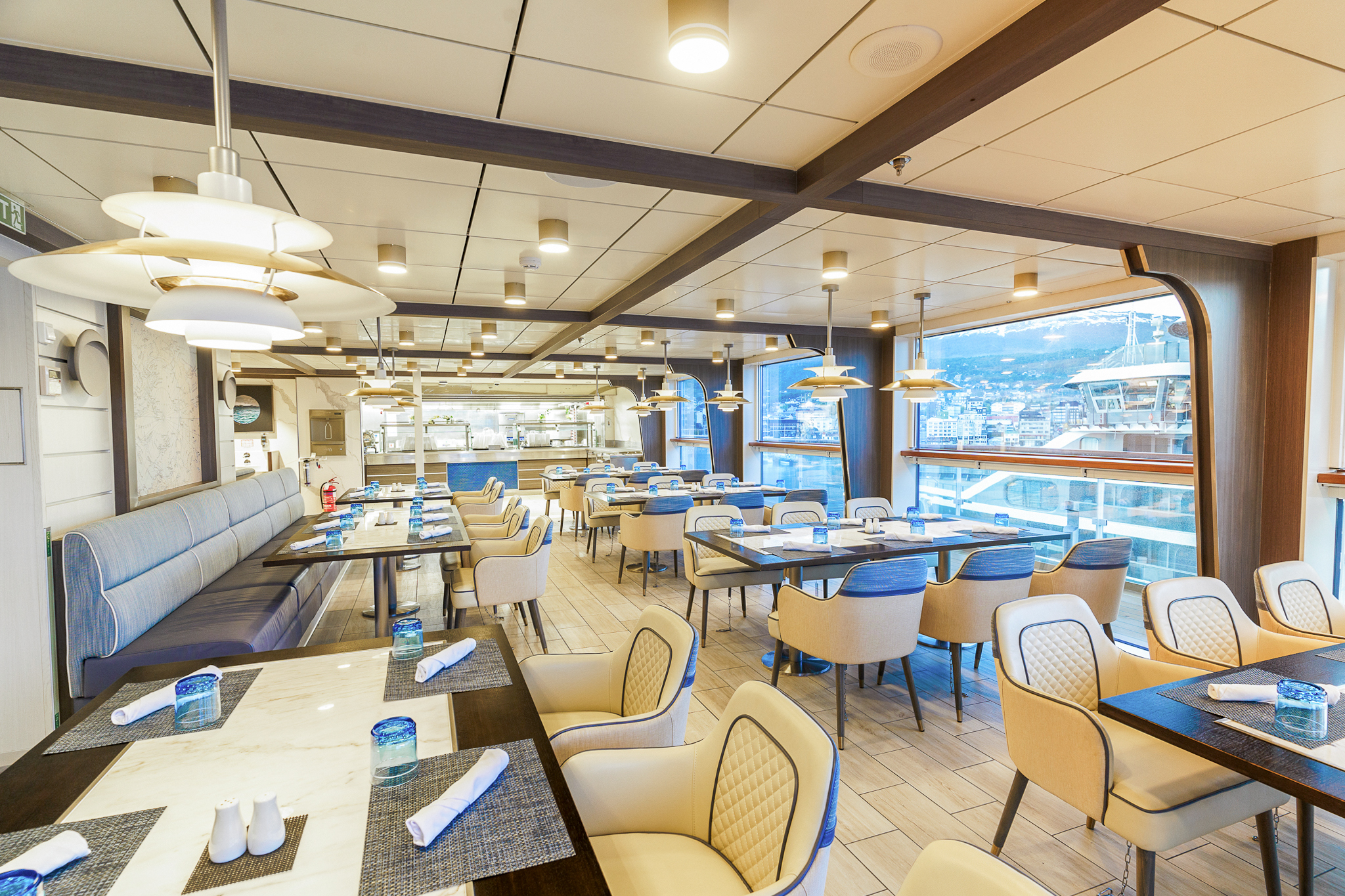
Observation Bistro
With its marine blue and off-white colors—is your go-to spot for lighter fare and graband-go snacks. This relaxed eatery seats up to 44 guests, who can take in full views of their polar surroundings and wildlife while enjoying a light bite.
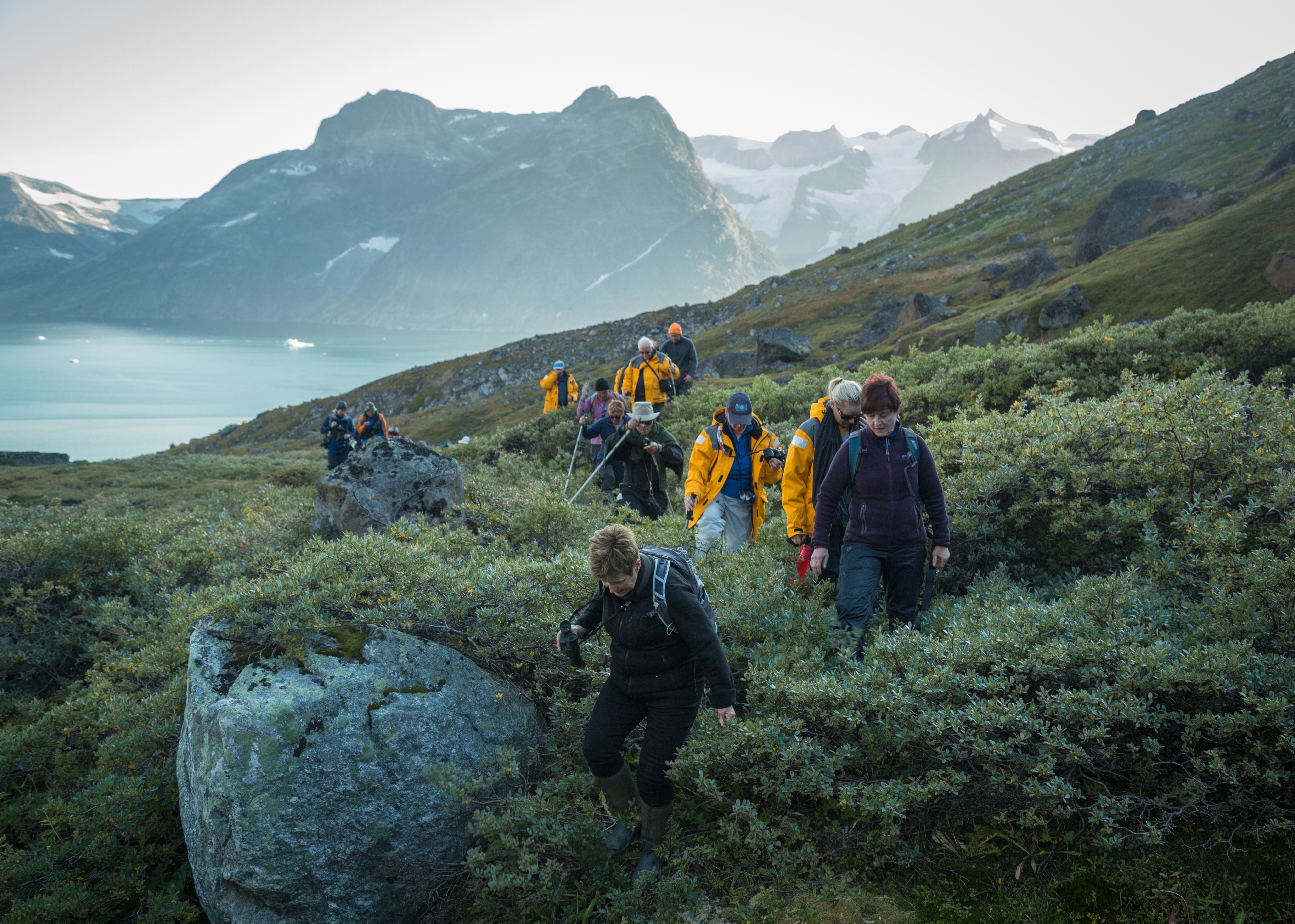
Off-Ship Adventures
With four separate sea-level embarkation points and a fleet of 15 Zodiacs, Ocean Explorer offers a comprehensive breadth of off-ship activities including Zodiac cruising and paddling, allowing you to intimately connect with the polar wilderness.

Expedition Team
The perfect polar expedition doesn’t just happen. It takes a team of talented, knowledgeable and experienced professionals to bring it all together. Our Expedition Team is comprised of seasoned veterans with rich backgrounds in marine biology, history, glaciology, geology and more. With the highest staff-to-guest ratio in the industry, our Expedition Teams safely deliver your trip-of-a-lifetime to maximize your polar adventure every step of the way.

Zodiac Cruising
Zodiacs are used for transferring you ashore, transporting your luggage when necessary and for taking you ocean-level cruising among icebergs, whales and seabirds. During the expedition, you will visit remote and isolated sites that are accessible only by Zodiac.
These large, heavy-duty inflatable vessels are extremely safe and were specially designed for expedition work. Zodiacs are the workhorses of Polar expeditions. Separate air compartments retain a large reserve of buoyancy even if these sturdy boats are damaged. Their flat bottom design permits the craft to land directly onto the cobble and ice-strewn beaches that you will encounter on your Polar expedition.
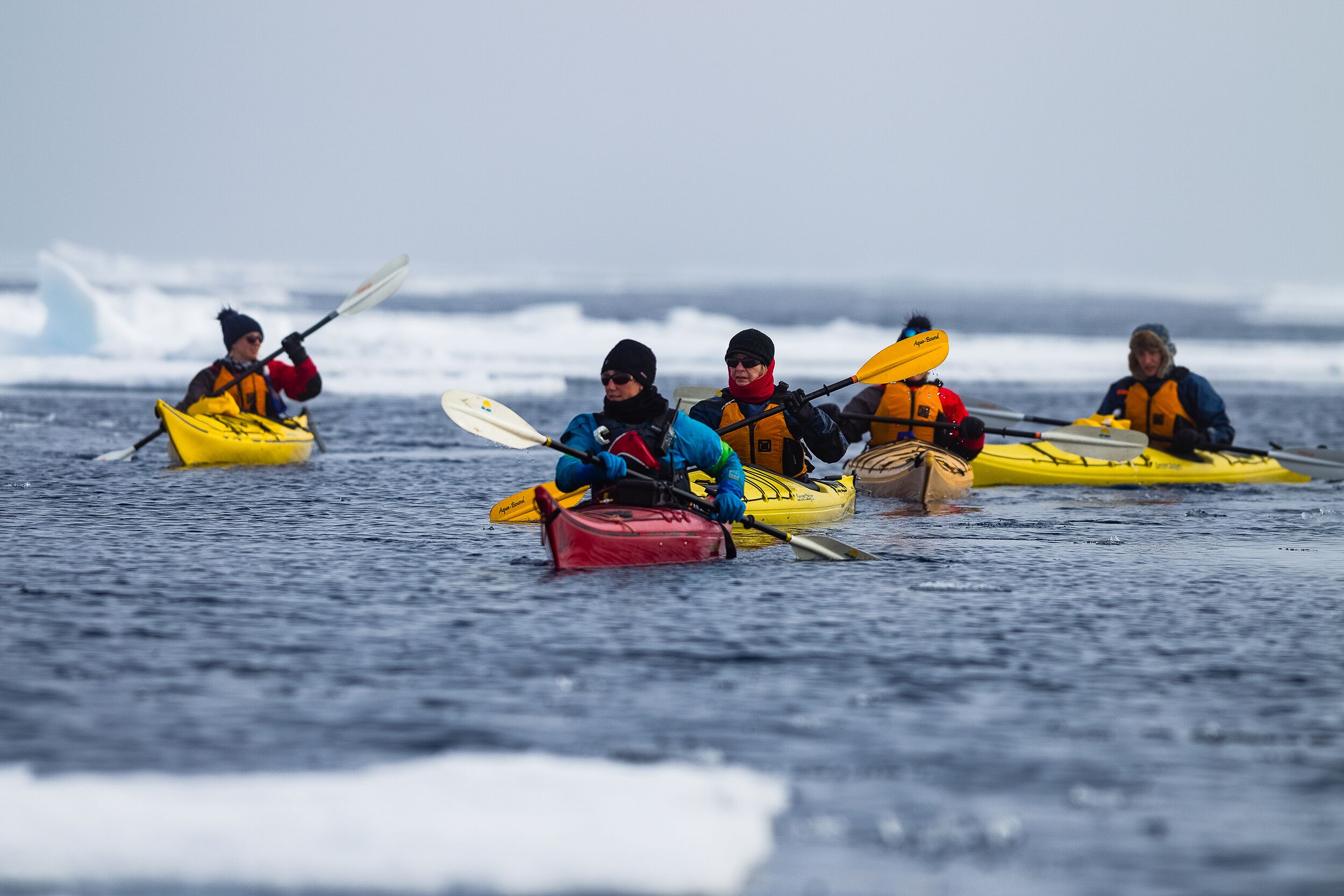
Sea Kayaking
The kayak adventure option is open to all levels of experience. However, it is highly recommended that you have some sea kayaking related experience prior to kayaking in the polar regions with Quark Expeditions. Our sea kayaks are the ideal means by which to slow down and connect with the pristine natural environments and surroundings.
Positioning yourself in the seat of a kayak is one of the most intimate ways travelers can connect with the polar regions—at water level, up close, where you can touch and feel every polar sensation imaginable. The Sea Kayak Program enables a small group of like-minded individuals to forge bonds as they explore fjords, glacial faces or mazes of sea ice.
Conditions and logistics permitting, your kayak guide(s) will endeavor to have you paddling as often as possible throughout the voyage. Typically, sea kayakers are shuttled by Zodiac from the ship to an ideal starting point, where the kayak excursion begins. Guests return to the ship by Zodiac at the end of their paddling experience. Some kayak excursions are designed so guests can go ashore and explore.
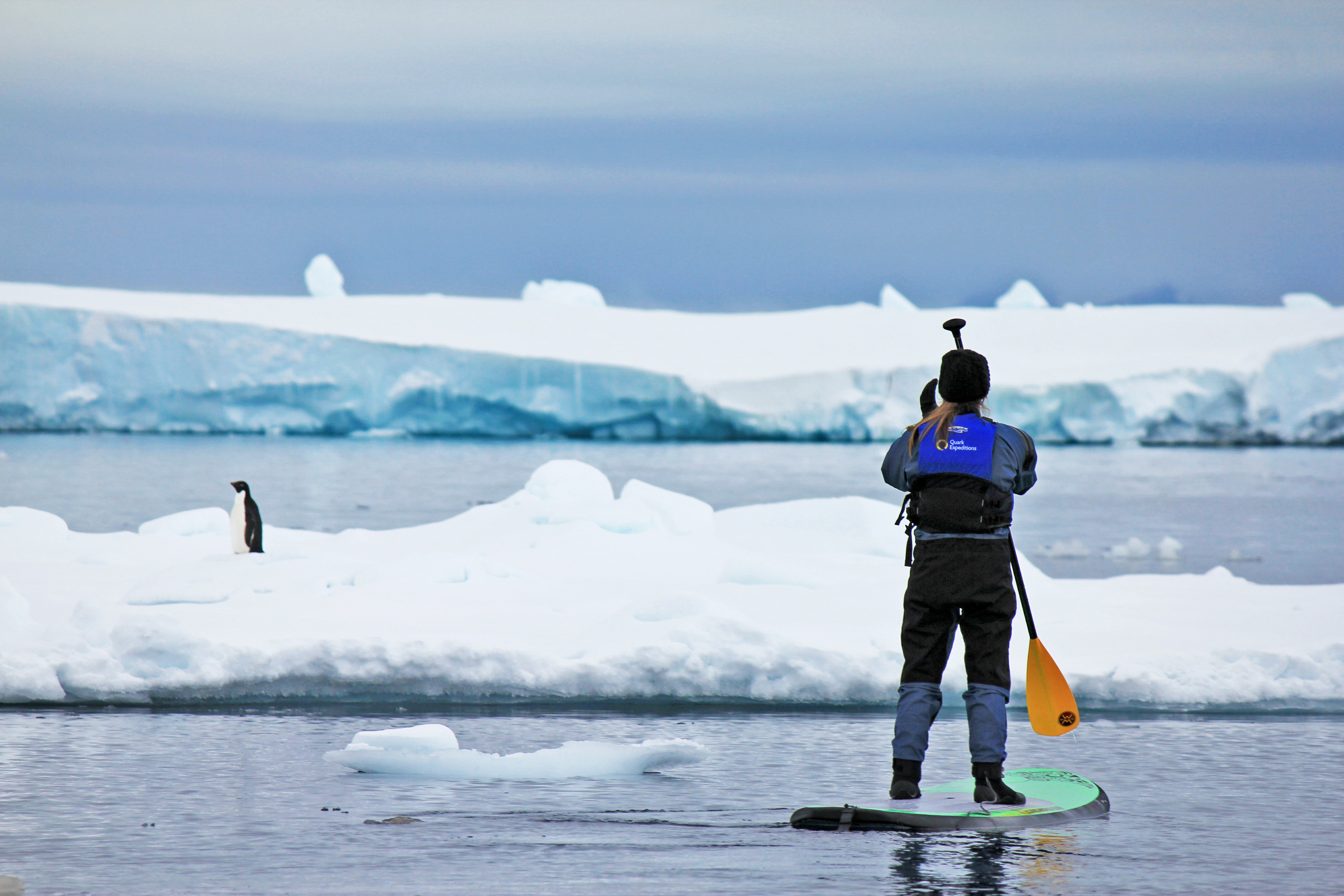
Stand-up Paddleboarding
Stand-up Paddleboarding, popularly known as SUPing, originated in Hawaii. Quark Expeditions is the first company to bring this watersport all the way to Antarctica.
SUPing combines the immersive experience of kayaking but in a standing position. Participants, if they prefer, can kneel, sit or even lie down and stare up at the azure Antarctic sky. Because of their wide base and tail fins, SUP boards are quite stable, enabling participants – after a bit of practice – to stop staring at their feet and admire the surrounding scenery. Imagine seeing Gentoo penguins gliding below you, or making eye contact with a Weddell seal lying on a piece of ice as you paddle by.
Guests receive on-ship and on-water instruction from a qualified SUP guide. In addition, a safety driver (in a Zodiac) stays within range to offer assistance.
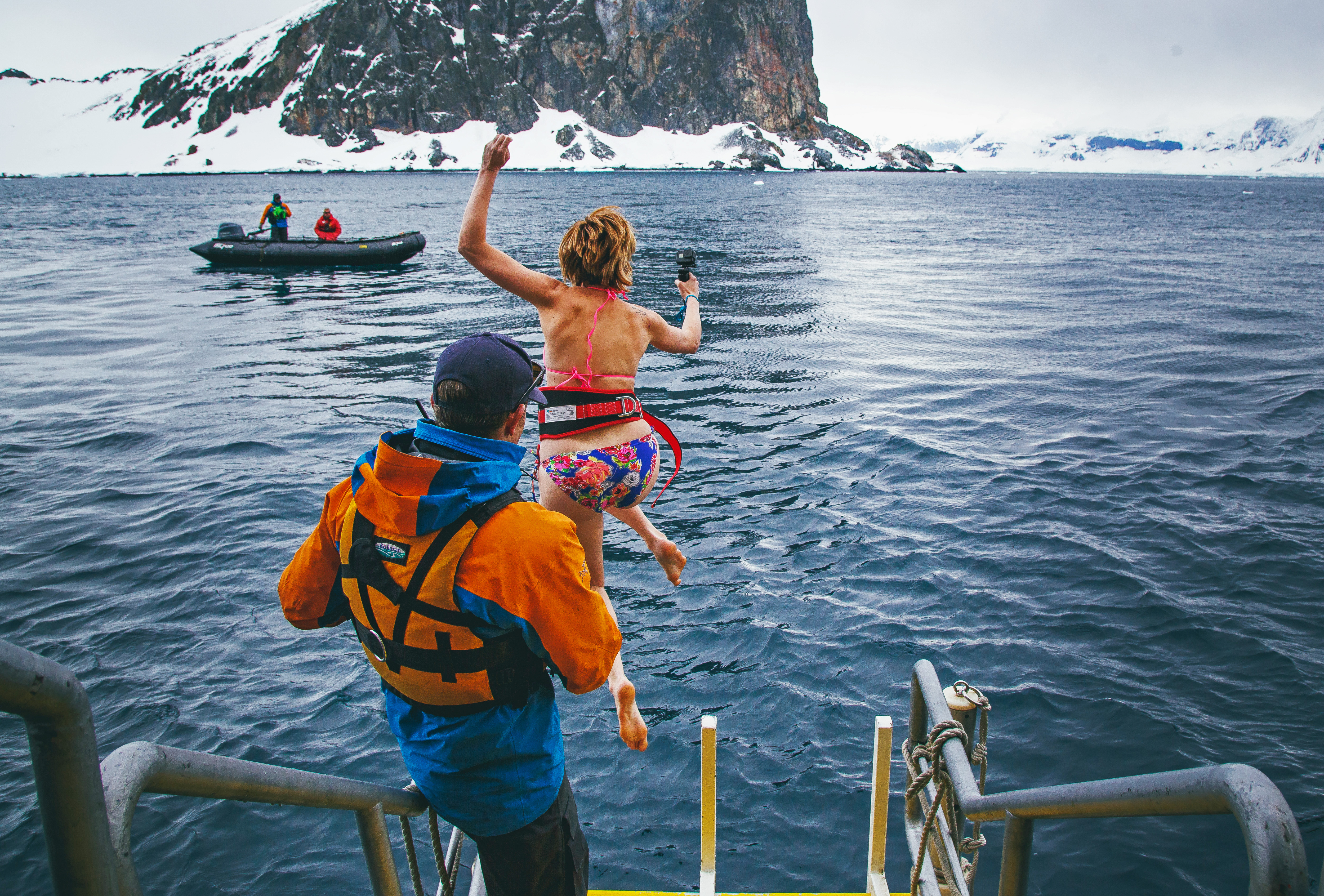
Polar Plunge
The Polar Plunge is scheduled once during each voyage. Throughout the journey, the Expedition Leader and Captain constantly monitor conditions in order to choose the optimal time and location. The Polar Plunge sometimes takes place onshore or, in many cases, from the gangway or Zodiac. All participants wear a tethered harness and plunge into the polar waters from the side of Zodiac or safety of the gangplank cheered on, of course, by fellow passengers and Expedition Team.
Safety is paramount—the onboard physician always attends the Polar Plunge. Guides in survival gear circle the area in Zodiacs as guests take their turn jumping or cannon-balling into the polar waters.
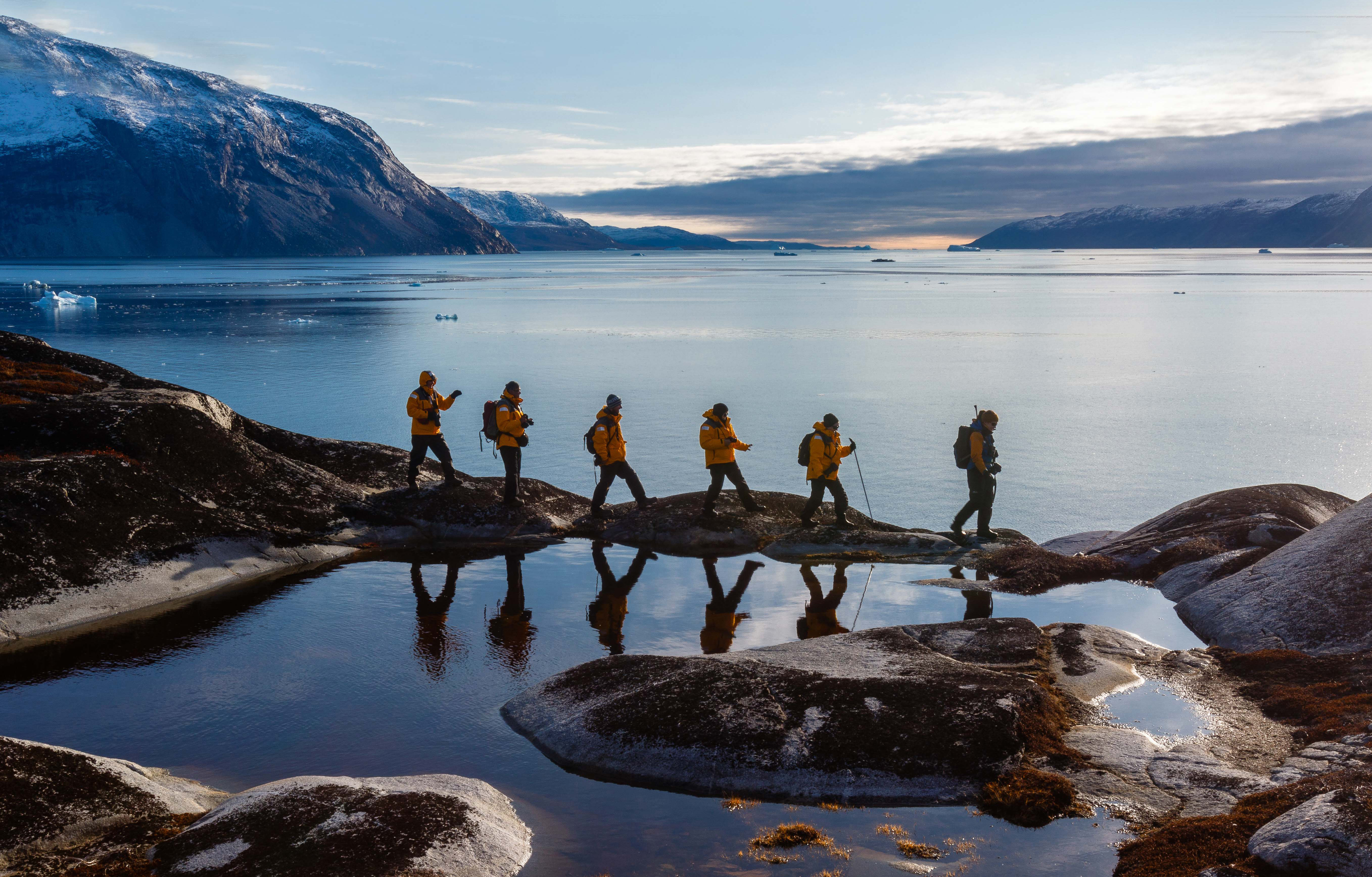
Hiking
Hiking in the polar regions differs from your typical trail experience. Here, in a tree-less terrain, you are the tallest figure on the landscape as you walk over spongy tundra, crusty snow or sandy beaches in remotes parts of the Arctic and Antarctica. Stepping ashore anywhere in the polar regions means you’re not a distant observer.
Our organized hikes range from short jaunts to the top of lookouts or visits to see wildlife or longer walks of several kilometers over ice and rock and snow. Hiking excursions may last from two to three hours with plenty of time for photographs of wildlife, learning moments from your experienced guides, or just time to stand back and admire the incredible polar surroundings.
No experience is necessary but participants should be able to get in and out of a Zodiac and walk on uneven terrain. Hiking options are tailored to all interests and abilities, from those who want to contemplate the landscape in silence to photographers who want that perfect image to energetic travelers who want to summit a peak in the hopes of seeing wildlife in their natural habitat.
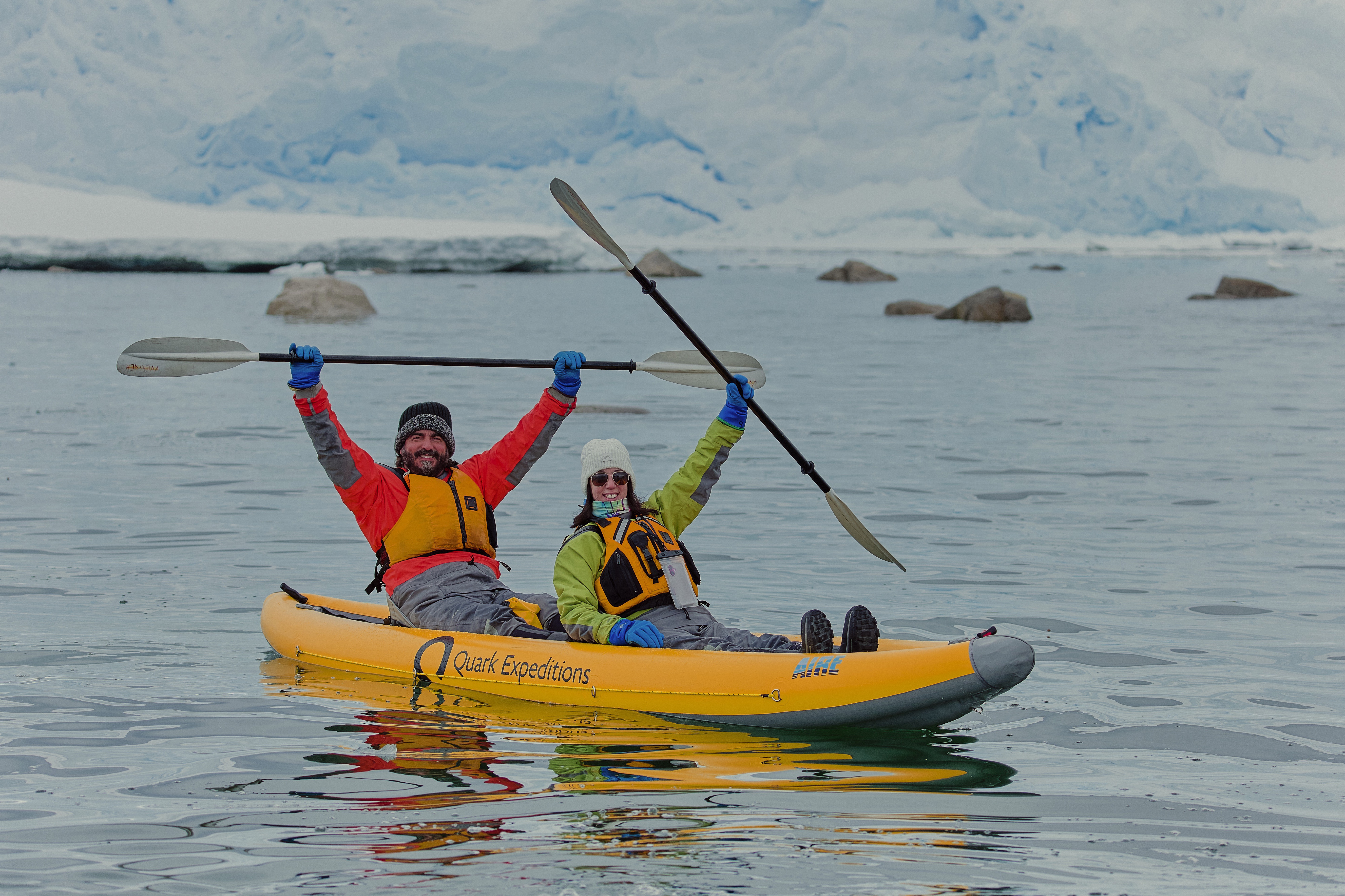
Paddling Excursion
Explore the ocean from a more intimate vantage point on a sit-on-top kayak. No experience is required to manoeuvre these very stable kayaks, allowing you to enjoy an unforgettable experience on the water, taking in breathtaking landscapes and wildlife. Whether it’s your first time in a kayak or you want greater flexibility to try other Adventure options, this shorter excursion is for you.
Paddling in the Polar Regions is highly weather-dependent and a one-time experience. Your kayak guides will attempt to take you out on the water for 1-1.5 hours of paddling. Offered on most voyages, spaces are limited. All equipment, guides and instructions are provided by Quark.
Pricing subject to change based on season. Please proceed to checkout or contact a Polar Travel Adviser for more details.
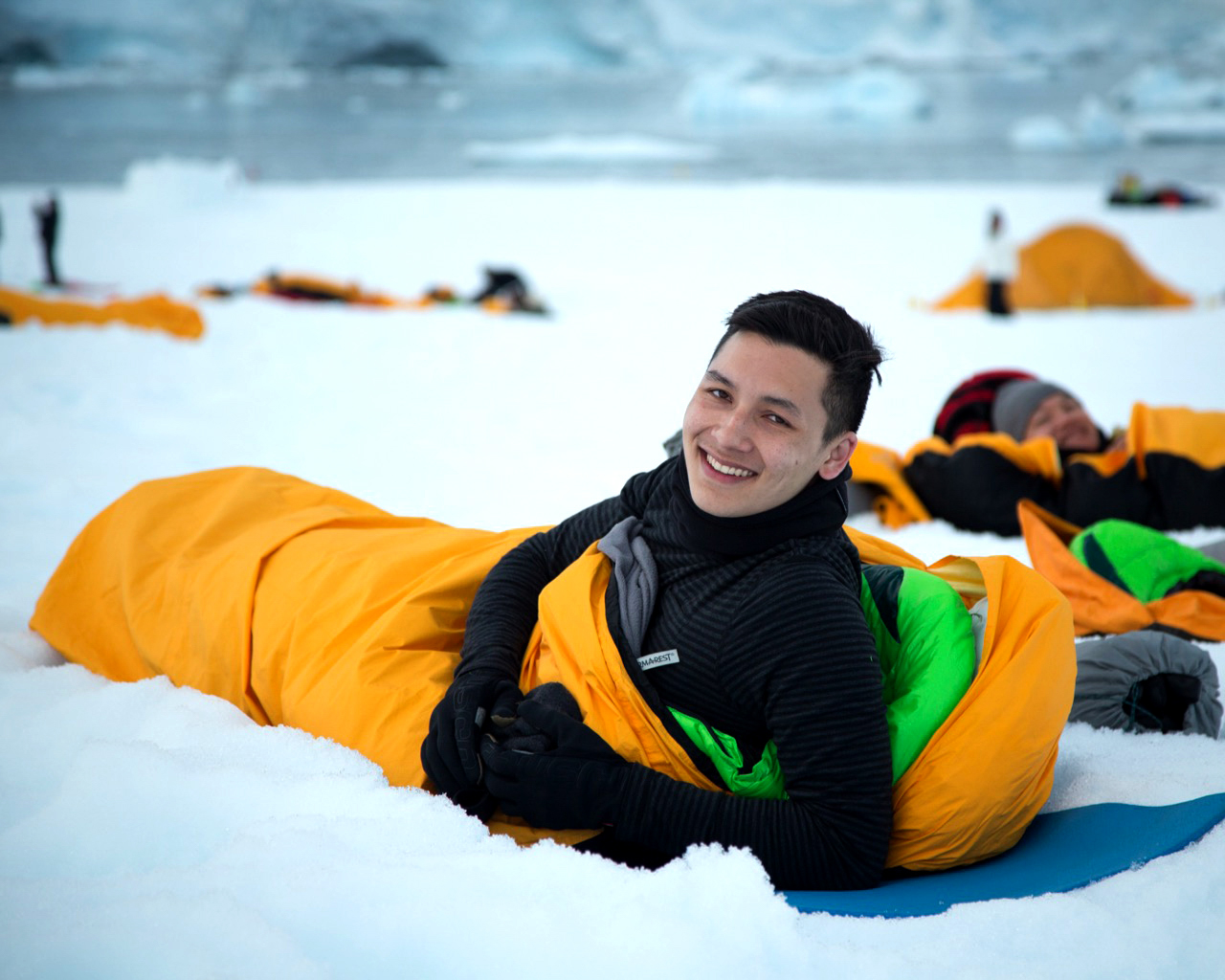
Camping
Imagine for a moment, staring at the stars in the indigo glow of an Antarctic night as you bed down for the night outside in the elements. The buzz of your daily life becomes a distant memory as you listen to the bray of penguin, the ethereal calls of the Weddell sea – even the exhalation of a humpback whale. And then you fall asleep.
Antarctic Camping with Quark Expeditions is an unforgettable experience. After dinner onboard, you’ll be escorted ashore by Zodiac to camp out on the snow for the night in your ready-to-roll bivy sack (tents can be used upon request). Once you decide on your spot, you set up camp and enjoy the peace as the Antarctic night unfolds.
Camping in Antarctica is limited to 50 participants, all of whom will be briefed beforehand on the principals of basic camping. Prior to you settling down for the night, Quark Expeditions staff will prepare the site, including setting up a perimeter in safe, flat to gently-sloping and beautiful site. You’re free to choose where (within the perimeters) you want to settle down for the night.
You’ll be equipped with the following:
- Mummy-style sleeping bag
- Bivy sack
- Insulated sleeping pad
- Sleeping bag liner
- 3 or 4 season tent provided upon request (pending availability)
- Quark Expeditions Parka
- Waterbottle (Small collapsible reusable water bottles provided onboard upon embarkation)
- Muck Boots (insulated waterproof boots provided onboard upon embarkation)
Other recommended gear:
- Base and mid-layer clothing
- Warm hat
- Warm gloves
- Hand-warmers
- Camera and accessories
- Backpack
- Eye mask if you wish complete darkness
- Need a pillow? Roll up your parka!
- Essential medication and or supplements
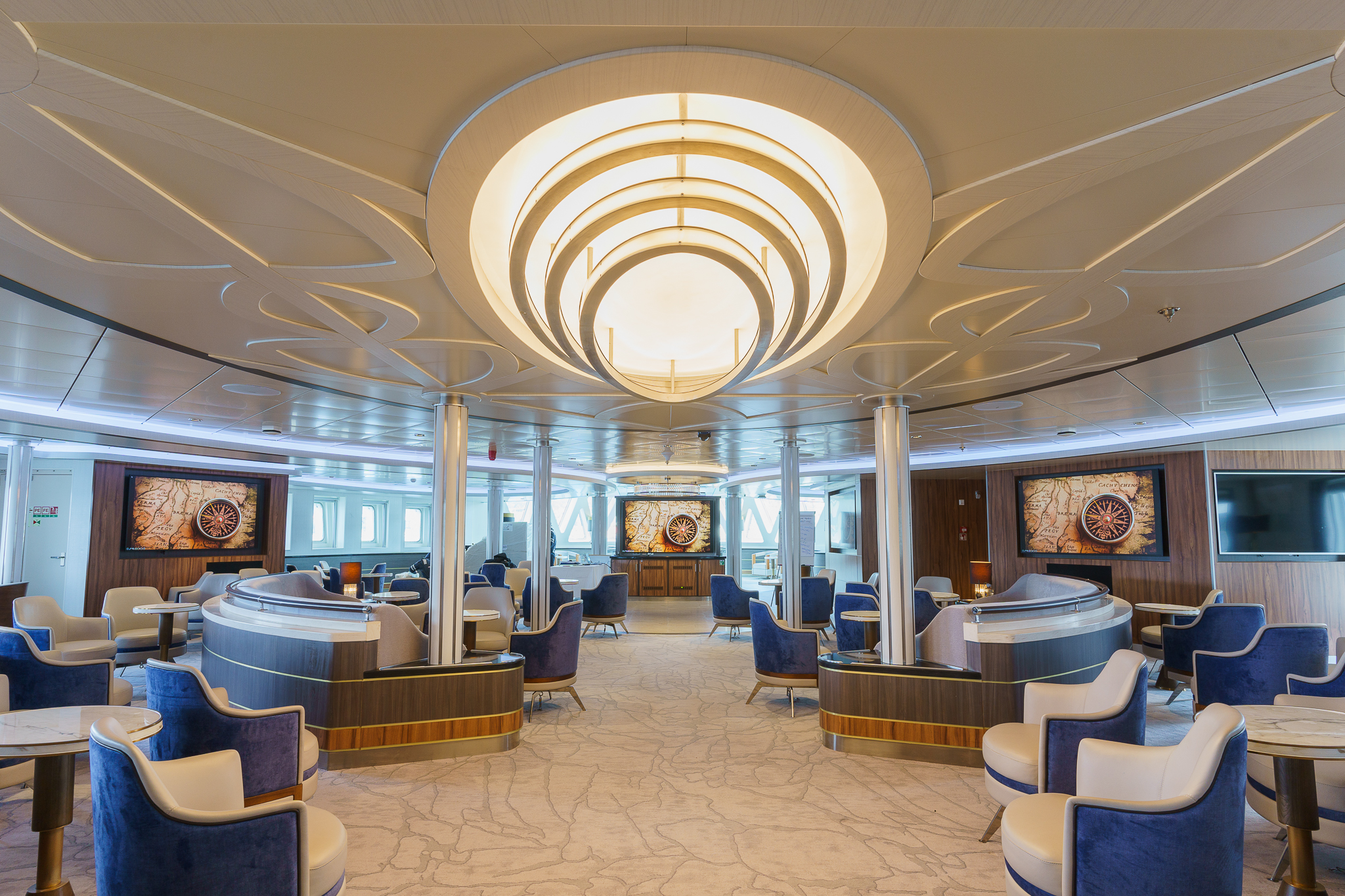
Explorer Lecture Lounge
Enjoy daily chats with and presentations by our world-class onboard polar experts—expedition guides, specialists, photography guides and other special guests who will introduce you to the fascinating history, biology, ornithology, glaciology and geology of the region, and much, much more.

Photography
Documenting your voyage so you can take the memories home is a rewarding experience. Our photography guides will help you hone your skills to capture the beauty of the polar regions.
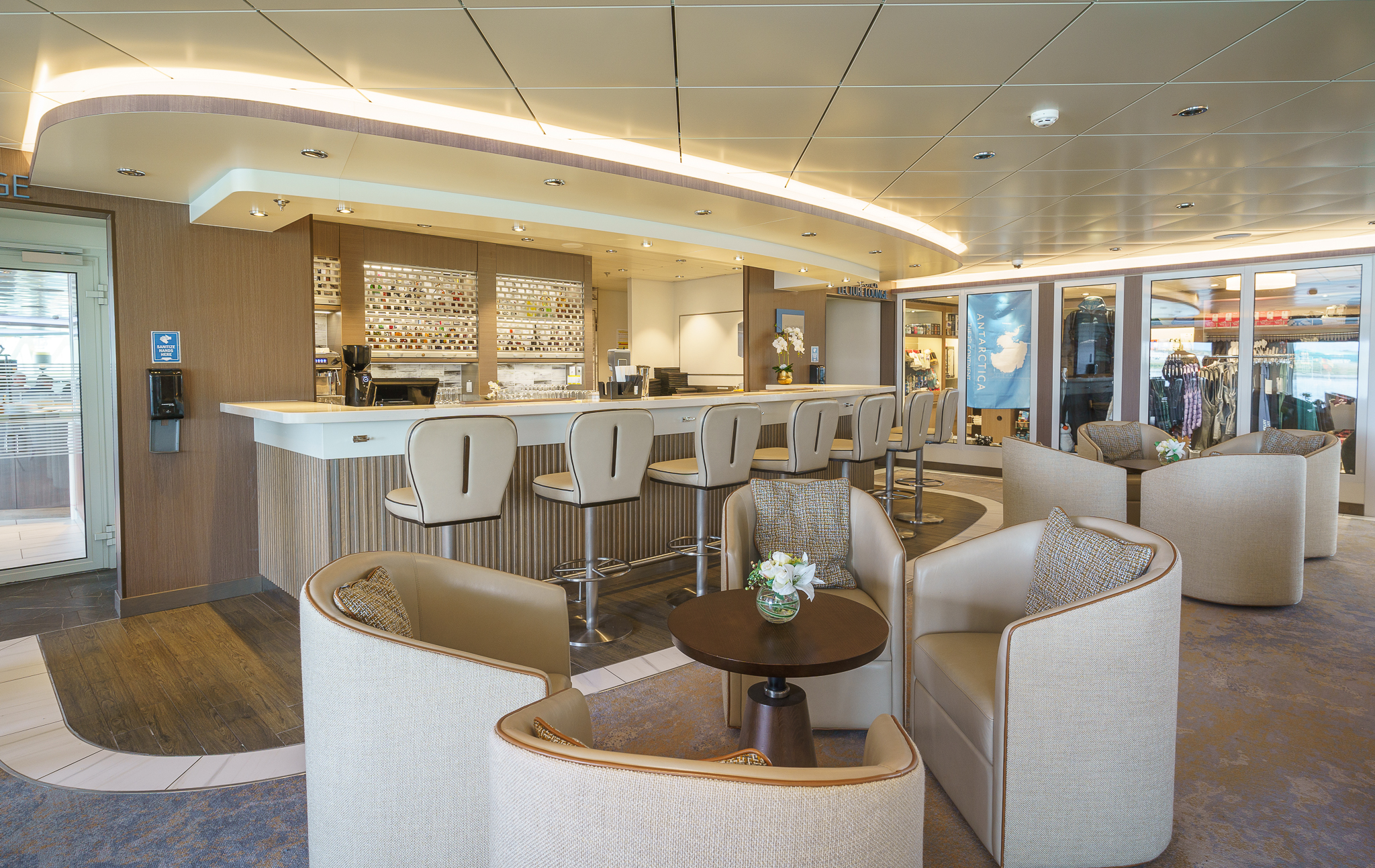
The Latitude Bar
A popular social hub on Deck 5, the beautifully-lit Latitude Bar—with its lush sofas and faux marble-topped end tables—is large enough to seat 46 and is ideal for enjoying a quiet drink on your own or hanging out with friends.
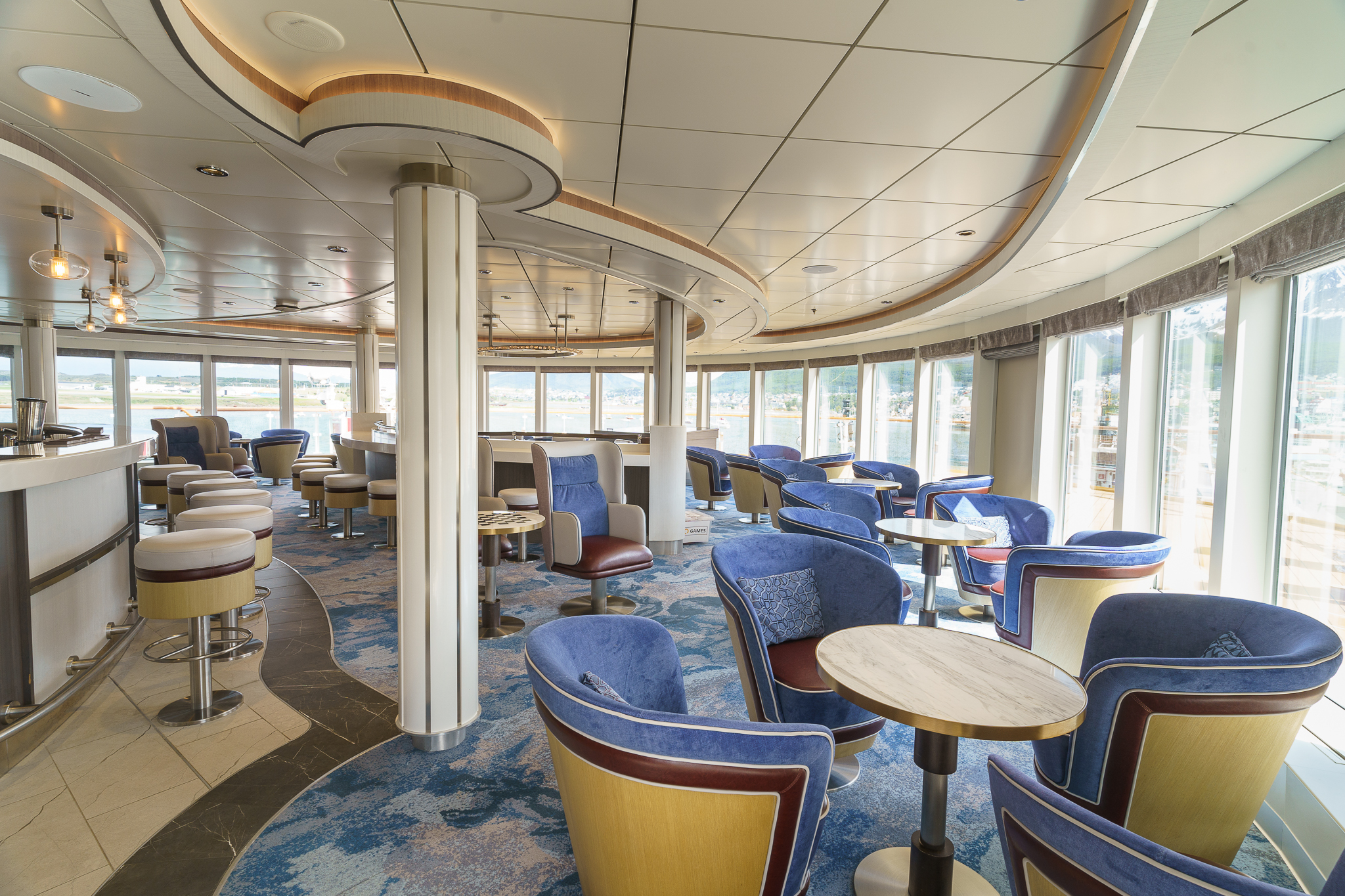
Observation Lounge
This stylish lounge at the top of the ship guarantees incredible views. Guests also frequent this spacious lookout on Deck 8 to enjoy cocktails and conversation with fellow travelers. Seats 63.

Discovery Library
Located on Deck 6 at the top of the gorgeous atrium staircase, this beautiful Library with floor-to-ceiling glass, accommodates up to 47 people
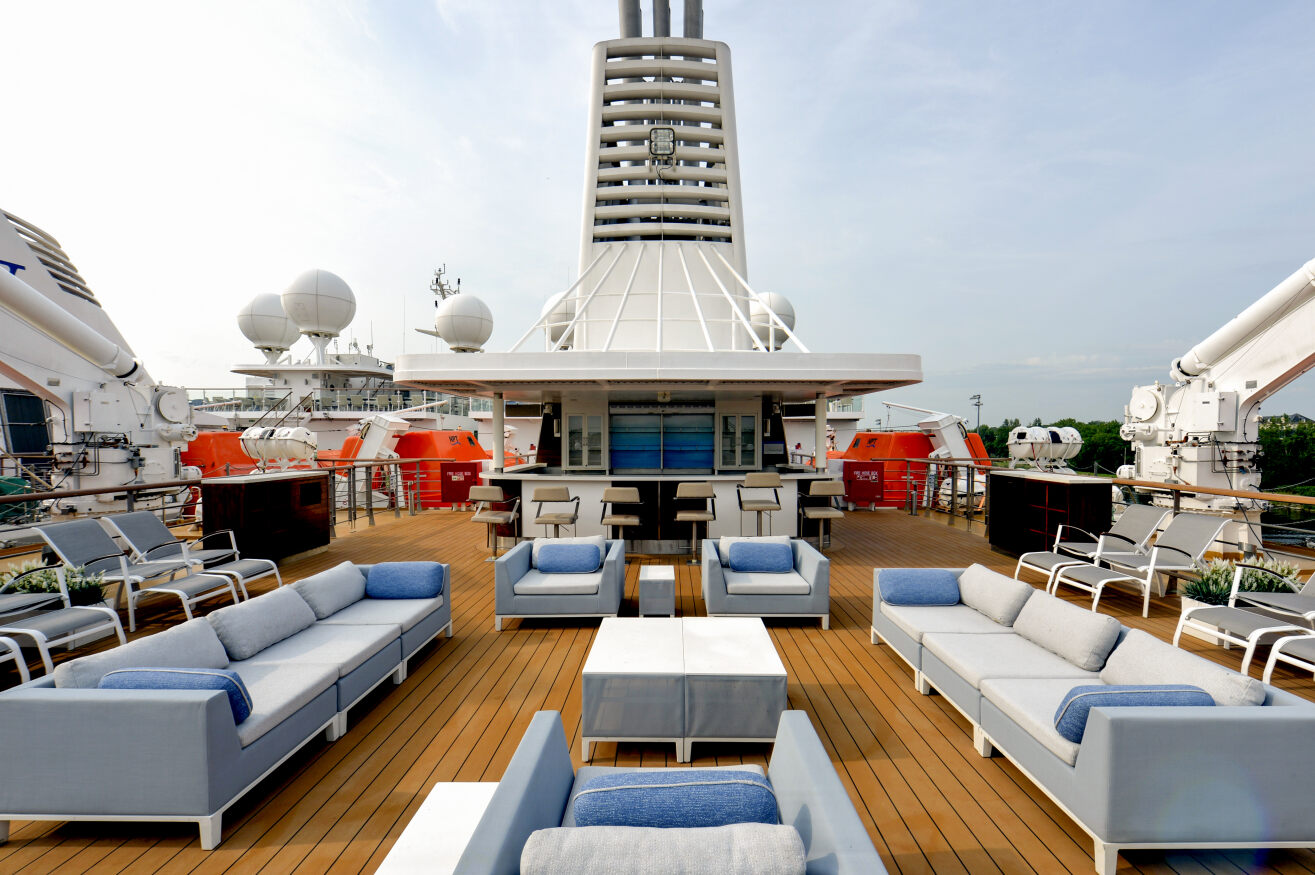
Sun Deck and Bar
More information coming soon.
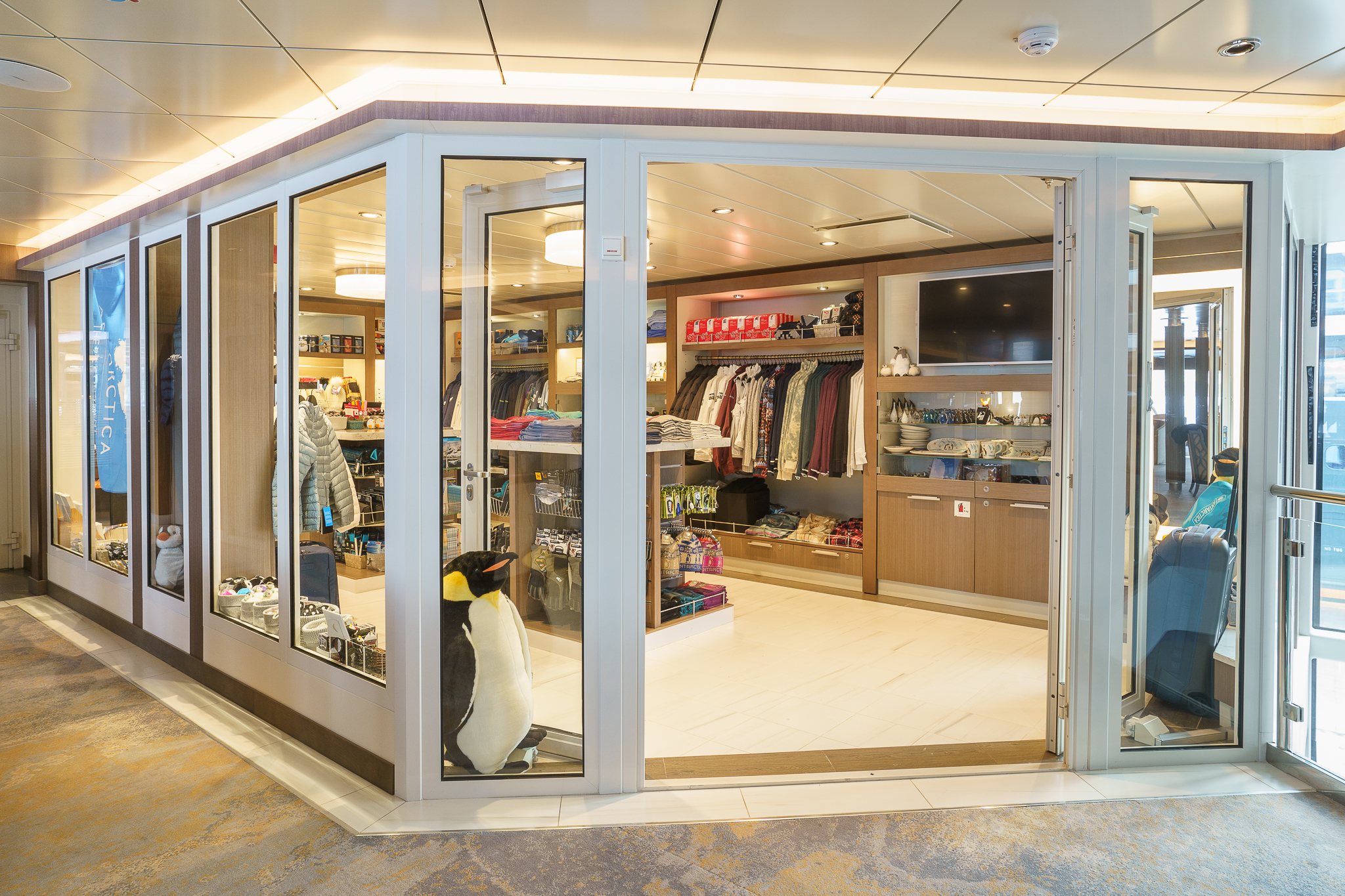
Polar Boutique
The Polar Boutique can be located on Deck 5.

Jacuzzis
Two outdoor Jacuzzis on deck 7, at the ship’s stern, mean you can relax alfresco while soaking up the breath-taking polar views.
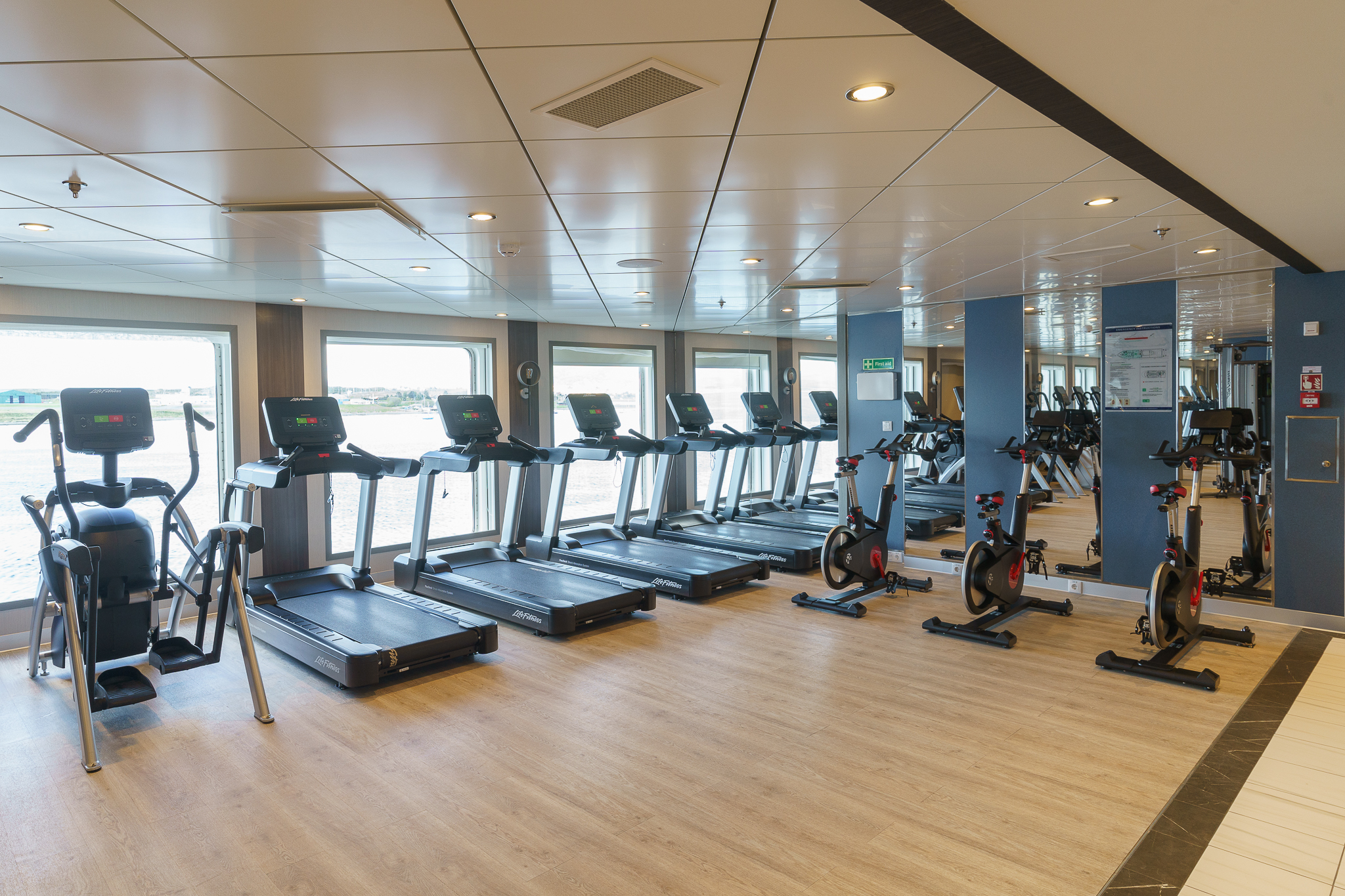
Fitness Centre
Stay fit with the latest work-out equipment in the Fitness Center on Deck 7.

Dry Sauna
After a day of exciting off-ship adventure, guests can relax on the sauna’s traditional wood benches while gazing at the polar wilderness just outside the large sauna windows. Accommodates 15 people on Deck 7.
Leading Edge Sustainability
With the latest sustainability technology in polar expedition, the ship features fuel-efficient Rolls-Royce engines and the ground-breaking MAGS gasification system that converts waste into energy, eliminating the environmental impact of waste transportation.
Medical Facilities
Quark Expeditions provides an English-speaking doctor on board who manages a medical clinic stocked with a supply of common prescription medicines and basic first aid equipment.
If you are under regular treatment for any ailment, you must bring a sufficient supply of medicine. We recommend that you pack an extra two weeks’ supply of medication in case of emergency. We cannot accept responsibility for not having a specific brand or type of drug on board. Should you fall ill, the doctor will refer to the medical forms that you completed and returned to us; therefore it is vital that the information you provide is complete and accurate
Dress Code
To Wear on Board
- Comfortable casual clothing like lighter shirts, pants or jeans, etc. (in case the ship gets warm)
- Comfortable non-slip closed-toed, heelless shoes (flip flops, sandals or slip-on shoes should not be worn on board due to safety concerns)
- Workout attire (for the fitness center and other indoor activities)
- Swimsuit (for the Polar Plunge! Some vessels may also have a pool, hot tub, sauna and/or steam room. See your ship book for details.)
Just a reminder: no formal evening wear required on our voyages! (but if you want to you can bring a little something more dressy for the Captain’s Welcome and Farewell cocktail parties)
Additional Items
- Passport, visas, immunization records, travel documents, etc. as required
- Camera gear complete with charger, storage medium, transport & cleaning kit (lens cloth etc.) and extra batteries
- Waterproof cell phone case or rain sleeve for camera
- Earplugs and eye masks for sleeping
- Voltage converters and plug adapters (see ship book for details)
- Moisturizer for face and hands (skin dryness due to wind and temperature changes)
- Seasickness, indigestion, headache, or other medications
- Small amount of local currency (see pre-departure book for more details)
- Insect repellant
- Mosquito netting
For Shore Excursions & Hiking
In addition to the mandatory gear requirements (as above) for the transit from ship to shore, it is recommended to bring:
- Worn-in Hiking footwear: While Muck-boots are provided and encouraged for most shore excursions, additional hiking footwear (Goretex-lined boots or similar water-proof hiking boots) can add to your hiking comfort, especially if you are a keen hiker
- (Smart) Wool or synthetic hiking socks for above footwear (bring an extra pair)
- Lightweight and quick-dry, trekking pants that may or may not convert to zip-off shorts* (*depending on your thermo-regulation)
- Breathable waterproof pants* and rain jacket** for outdoor activities in inclement weather (*can be the same pair you use for Zodiac operations / ** can be outer shell of complimentary Quark 3in1 Parka)
- Comfortable long or short-sleeve shirt for hiking either synthetic/quick-dry or merino (smart) wool
- (Hiking) gloves (medium thickness, waterproof preferred)
- Hat, buff or scarf (for wind and weather protection)
- UV protection (hat, polarized sun glasses, sun block, lip balm)
- Collapsible Walking stick for hikes (if required). Quantities are available on every vessel to borrow.
- Additional reusable thermos or water bottle (in addition to the reusable collapsible water bottle provided)
By Sea & Air
All transfers ship to shore, helicopter flights & Zodiac/ship cruising
- Waterproof Pants (Mandatory for every Zodiac and helicopter ride. For Ultramarine guests who are participating in Helicopter flights, we recommend packing loose fitting rain pant style waterproof pants, rather than fitted ski pants. You will also be required to wear a drysuit, which our team will help you prepare for on the ship.)
- Base-layer wool or synthetic top*
- Base-layer wool or synthetic bottom*
- Mid-layer warm or fleece top*
- Mid-layer warm or fleece bottom*
- Warm hat that covers ears (bring an extra)
- Scarf, buff, or other face protection
- Warm wool or synthetic socks (keep a dry pair in your bag, and bring extras for layering)
- Waterproof gloves or mitts (bring an extra, lighter pair for hiking)
- Glove liners*
- Hand and feet warmers*
- Binoculars
- Polarized sunglasses with UV protection (bring an extra pair)
- Sunscreen
- Ski goggles (for Zodiac cruising on snowy or windy days)
- Waterproof, lightweight backpack or dry sack &/or rain sleeve for camera or a waterproof phone case (to keep camera & gear dry)
Smoking Policy
To protect the health and safety of its guests, Quark Expeditions® maintains a no smoking policy in the interior of the ship including cabins, near Zodiacs and on landings. Smoking on the ship is permitted in the designated smoking area only, which your Expedition∘ Team members will be happy to point out for you. Always make sure to extinguish cigarettes properly and dispose of them in the proper receptacle. Please, never throw cigarettes overboard.
Dietary Requirements and Allergies
All guests—including vegetarians, meat-eaters, as well as those who follow a gluten-free diet—will be equally impressed with the dining options on our ships. Quark Expeditions® is able to cater to most special dietary requests, as long as you clearly indicate your needs on the required expedition forms when you book your voyage. Menus will be clearly labeled for vegetarian and gluten free options, but please do notify your server of the dietary restrictions you indicated on your form. We regret that kosher food cannot be prepared.
Laundry
A complete list of laundry fees will be provided on board. Laundry is collected each morning; please allow 48 hours for your laundry to be returned. Ironing services are also available at a minimal charge. We encourage you to take advantage of the laundry services, as it will mean you can pack fewer articles of clothing. If you prefer to hand wash small items in your cabin, please remember to bring environmentally friendly detergent.
Wi-Fi & Communications
When you are not busy exploring the natural beauty of the Polar Regions, you may wish to connect with family and friends back home to share some of your voyage highlights. Guests on Quark Expeditions can now enjoy free Wi-Fi as part of our “Raise a Glass and Stay Connected Free” program. This complementary Wi-Fi service permits basic Internet browsing and voice applications.
Please note that we travel to some of the most remote parts of the world. As we utilize satellite equipment for our connection, Wi-Fi signal may be intermittent.
To access email or internet on your personal computer, tablet or smart phone, connect to the network on your device, where you can access our complimentary plan, or purchase Priority Wi-Fi.
Complimentary Wi-Fi
- Lower speeds
- Suitable for basic internet browsing, texting and voice calling using text and voice apps
- Some site filtering
- No charge
- One device logged in at a time
Priority Wi-Fi
- Higher speeds
- Suitable for larger data volume apps, video calling, video streaming (in lower resolutions) etc.
- See rates by logging in
- One device logged in at a time
Expedition Brochures
Find Ocean Explorers itineraries here.

Deck 9
- Top Deck

Deck 8
- Observation Deck
- Observation Bistro
- Observation Lounge & Bar
- Elevator

Deck 7
- Penthouse Suite
- Owners Suite
- Veranda Stateroom
- Studio Veranda Single
- Polar Deck and Bar
- Jacuzzis
- Gym
- Tundra Spa & Sauna
- Bridge
- Bridge Deck
- Elevator

Deck 6
- The Discovery Library
- Junior Suite
- Veranda Suite
- Veranda Stateroom
- Elevator

Deck 5
- Main Dining Room
- Private Dining Room
- Reception
- Polar Boutique
- Latitude Bar & Lounge
- Explorer Lecture Lounge
- Elevator

Deck 4
- Deluxe Veranda Forward
- Veranda Suite
- Veranda Stateroom
- Expedition Desk
- Elevator

Deck 3
- Ready Room
- Medical Facilities
- Zodiac Embarkation Points
- Studio Single
- Elevator
